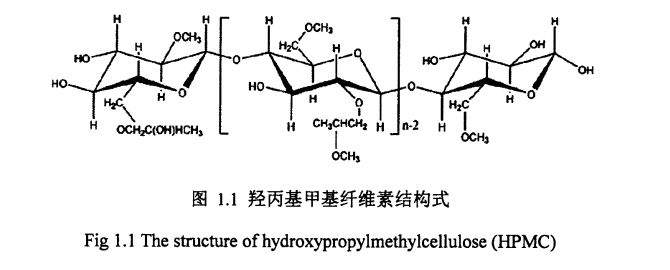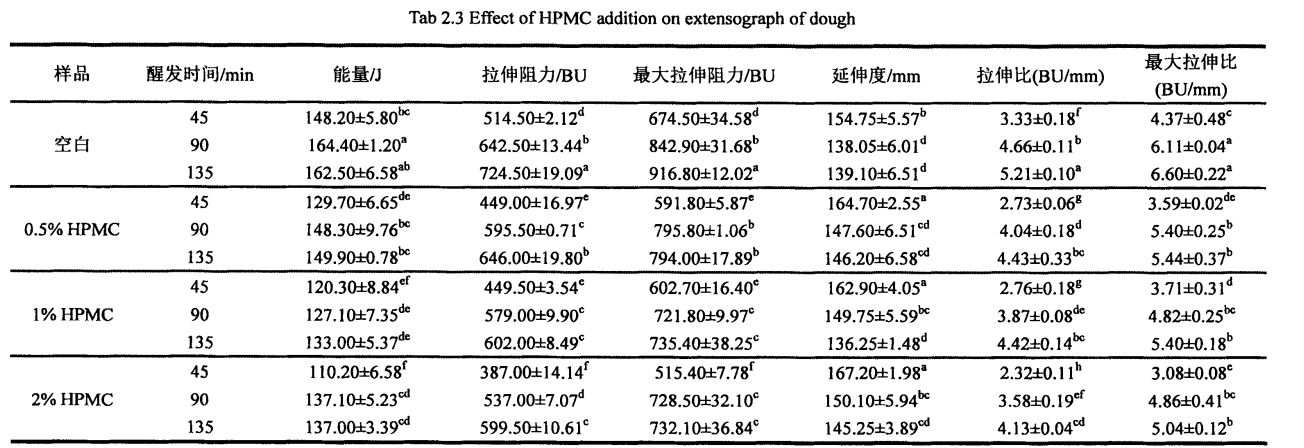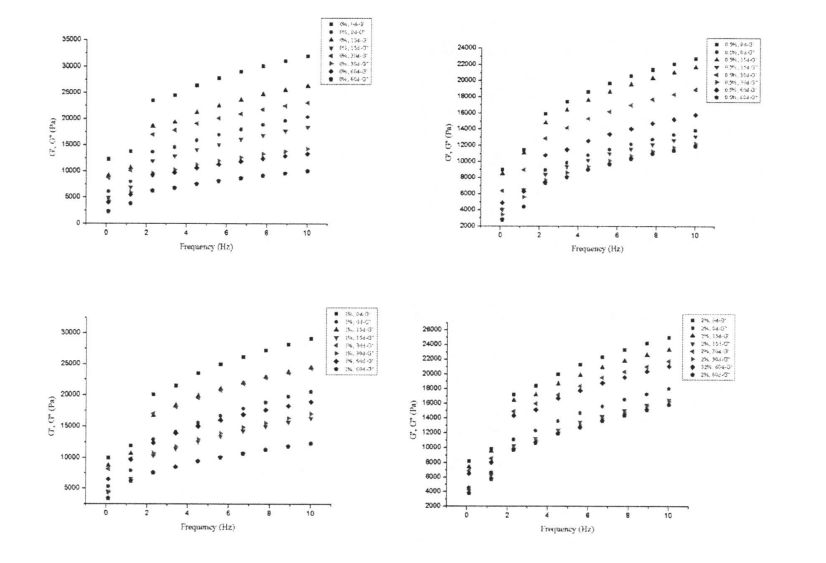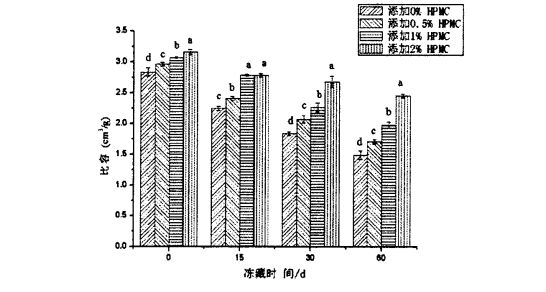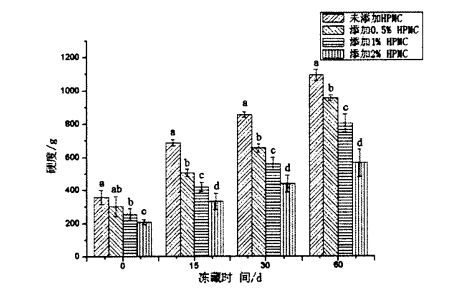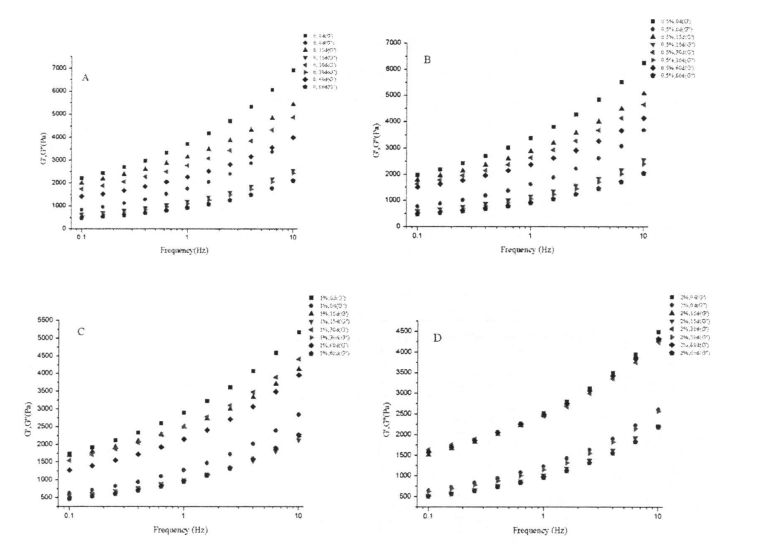Wheat gluten is the material basis for the formation of dough network structure. Experiments found that the addition of I--IPMC reduced the breakage of Yd and disulfide bonds between wheat gluten proteins during frozen storage. In addition, the results of low-field nuclear magnetic resonance and differential scanning the water state transition and recrystallization phenomena are limited, and the content of freezable water in the dough is reduced, thereby suppressing the effect of ice crystal growth on the gluten microstructure and its spatial conformation. Skananta elektronan mikroskopon montris intuicie, ke la aldono de HPMC povus konservi la stabilecon de gluten -reto -strukturo.
Starch is the most abundant dry matter in dough, and changes in its structure will directly affect the gelatinization characteristics and the quality of the final product. X. La rezultoj de X-radia difraktado kaj DSC montris, ke la relativa kristaleco de amelo pliiĝis kaj la gelatiniza entalpio pliiĝis post frosta stokado. With the prolongation of frozen storage time, the swelling power of starch without HPMC addition decreased gradually, while the starch gelatinization characteristics (peak viscosity, minimum viscosity, final viscosity, decay value and retrogradation value) all increased significantly; Dum la stokadotempo, kompare kun la kontrolgrupo, kun la kresko de HPMC -aldono, la ŝanĝoj de amelo -kristala strukturo kaj gelatinigaj proprietoj iom post iom malpliiĝis.
La aktiveco de fermentado de gaso de feĉo havas gravan influon sur la kvalito de fermentitaj farunaj produktoj. Through experiments, it was found that, compared with the control group, the addition of HPMC could better maintain the fermentation activity of yeast and reduce the increase rate of extracellular reduced glutathione content after 60 days of freezing, and within a certain range, The protective effect of HPMC was positively correlated with its addition amount.
1.1.2 Esplora Statuso de Vapitaj Bulkoj ………………………………………………. . ………… 1
1.1.3 Frosta pasto Enkonduko ………………………………………………………………………… 2
1.1.4 Problems and challenges of frozen dough………………………………………………………….3
1.1.7 Hydroxypropyl methyl cellulose (Hydroxypropyl methyl cellulose, I-IPMC) ………. 5
112 Intenco kaj Signifo de la Studo ……………………………………………………………… 6
1.3 La ĉefa enhavo de la studo ………………………………………………………………………… 7
2.2.1 Eksperimentaj Materialoj ………………………………………………………………………………………… 8
2.3 Experimental results and discussion…………………………………………………………………… . 11
2.4 Ĉapitra Resumo ……………………………………………………………………………………………………………………………………………
3.2.2 Eksperimenta Aparato ………………………………………………………………………………… 25
3.2.3 Experimental reagents…………………………………………………………………………. ……………… 25
3.2.4 Experimental methods ....................................................................................................... 25
3.3.2 The effect of adding amount of HPMC and freezing storage time on the freezable moisture content (CFW) and thermal stability……………………………………………………………………. 30
3.3.3 Effects of HPMC addition amount and freezing storage time on free sulfhydryl content (C vessel) …………………………………………………………………………………………………………. . 34
3.4 Ĉapitra Resumo ………………………………………………………………………………………………………………………………………………
4.1 Introduction .............................................................................................................................. . 44
4.2 Eksperimentaj Materialoj kaj Metodoj ................................................................................ 45
4.3 Analizo kaj Diskuto …………………………………………………………………………………………………………. 48
4.3.1 Content of basic components of wheat starch ……………………………………………………. 48
4.3.3 Effects of HPMC addition and freezing storage time on the shear viscosity of starch paste………………………………………………………………………………………………………………………………………. 52
4.3.5 Influence of HPMC addition amount and frozen storage time on starch swelling ability……………………………………………………………………………………………………………………………………….56
4.3.6 Effects of I-IPMC addition amount and frozen storage time on the thermodynamic properties of starch ………………………………………………………………………………………………………. . 57
4.4 Ĉapitra Resumo ………………………………………………………………………………………………………………………………………………… 6 1
Chapter 5 Effects of HPMC addition on yeast survival rate and fermentation activity under frozen storage conditions………………………………………………………………………………………………. . 62
5.1Introduction .................................................................................................................................... 62
5.2 Materials and methods ............................................................................................................ 62
5.2.1 Eksperimentaj Materialoj kaj Instrumentoj ....................................................................... 62
5.2.2 Eksperimentaj Metodoj. . . . . …………………………………………………………………………………………………………………………………………………………………. 63
5.3 Results and Discussion ............................................................................................................... 64
5.3.3 The effect of adding amount of HPMC and freezing time on the content of glutathione in dough……………………………………………………………………………………………………………66. "
5.4 Ĉapitro Resumo …………………………………………………………………………………………………………………………………………… 67
6.1 Conclusion ................................................................................................................................. . 68
6.2 Outlook .......................................................................................................................................... 68
Listo de ilustraĵoj
Figure 1.1 The structural formula of hydroxypropyl methylcellulose………………………. . 6
Figure 2.4 The effect of HPMC addition and freezing time on the elasticity of steamed bread………………………………………………………………………………………………………………………………. . 20
Figure 3.1 The effect of HPMC addition and freezing time on the rheological properties of wet gluten…………………………………………………………………………………………………………………………. 30
Figure 3.2 Effects of HPMC addition and freezing time on the thermodynamic properties of wheat gluten………………………………………………………………………………………………………………. . 34
Figure 3.3 Effects of HPMC addition and freezing time on free sulfhydryl content of wheat gluten……………………………………………………………………………………………………………………………... . 35
Figure 3.7 The effect of HPMC addition and freezing time on the microscopic gluten network structure…………………………………………………………………………………………………………... . 43
Figure 4.1 Starch gelatinization characteristic curve ............................................................... 51
Figuro 4.2 Flua Thixotropy de amelo -pasto ................................................................................. 52
Figure 4.3 Effects of adding amount of MC and freezing time on the viscoelasticity of starch paste……………………………………………………………………………………………………………………... . 57
Figure 4.5 Effects of HPMC addition and freezing storage time on the thermodynamic properties of starch…………………………………………………………………………………………………………. . 59
Figure 5.2 The effect of HPMC addition and freezing time on the yeast survival rate…………………………………………………………………………………………………………………………………... . 67
Figuro 5.3 Mikroskopa observado de feĉo (mikroskopa ekzameno) ……………………………………………………………………………………………………………………………………………………………………………………………………………………………………………………………………………. 68
Listo de formoj
Tabelo 2.1 La Baza Ingredienca Enhavo de Tritika Faruno ………………………………………………………………………………………………………………………………………………………………………………………………………………………………………………………………………………………………………………………………………………………………………………………………………………………………………………. 11
Tabelo 2.2 La efiko de i-I-IPMC aldono sur la Farinaceaj ecoj de pasto …………… 11
Table 3.1 Content of basic ingredients in gluten…………………………………………………………….25
Table 3.2 Effects of I-IPMC addition amount and freezing storage time on the phase transition enthalpy (Yi IV) and freezer water content (e chat) of wet gluten………………………. 31
Table 3.3 Effects of HPMC addition amount and freezing storage time on the peak temperature (product) of thermal denaturation of wheat gluten…………………………………………. 33
Table 3.6 Effects of I-IPMC addition and freezing storage time on the surface hydrophobicity of wheat gluten……………………………………………………………………………………………. 41
Tabelo 4.1 Enhavo de bazaj komponentoj de tritika amelo ………………………………………………… 49
Table 4.3 Effects of I-IPMC addition and freezing time on the shear viscosity of wheat starch paste…………………………………………………………………………………………………………………………. 55
1.1research statuso hejme kaj eksterlande
1.1.1 Enkonduko al Vapora Pano
Steamed bread refers to the food made from the dough after proofing and steaming. As a traditional Chinese pasta food, steamed bread has a long history and is known as "Oriental Bread". Because its finished product is hemispherical or elongated in shape, soft in taste, delicious in taste and rich in nutrients [l], it has been widely popular among the public for a long time. Ĝi estas la baza manĝaĵo de nia lando, precipe de la nordaj loĝantoj. La konsumo respondecas pri ĉirkaŭ 2/3 de la dieta strukturo de produktoj en la nordo, kaj ĉirkaŭ 46% de la dieta strukturo de farunaj produktoj en la lando [21].
Nuntempe la esplorado pri vapora pano ĉefe fokusas pri jenaj aspektoj:
1) Disvolviĝo de novaj karakterizaj vaporaj bulkoj. Through the innovation of steamed bread raw materials and the addition of functional active substances, new varieties of steamed breads have been developed, which have both nutrition and function. Establis la taksadan normon por la kvalito de diversspecaj grenaj vaporitaj panoj per ĉefa komponentanalizo; Fu et a1. (2015) added lemon pomace containing dietary fiber and polyphenols to steamed bread, and evaluated the antioxidant activity of steamed bread; Hao & Beta (2012) studied barley bran and flaxseed (rich in bioactive substances) The production process of steamed bread [5]; Shiau et a1. (2015) evaluated the effect of adding pineapple pulp fiber on dough rheological properties and steamed bread quality [6].
2)Research on the processing and compounding of special flour for steamed bread. The effect of flour properties on the quality of dough and steamed buns and the research on new special flour for steamed buns, and based on this, an evaluation model of flour processing suitability was established [7]; for example, the effects of different flour milling methods on the quality of flour and steamed buns[7] 81; La efiko de la komponaĵo de pluraj vaksaj tritikaj farunoj sur la kvalito de vapora pano [9J et al.; Zhu, Huang, &Khan (2001) evaluated the effect of wheat protein on the quality of dough and northern steamed bread, and considered that gliadin/ Glutenin was significantly negatively correlated with dough properties and steamed bread quality [lo]; Zhang, et a1. (2007) analyzed the correlation between gluten protein content, protein type, dough properties and steamed bread quality, and concluded that the content of high molecular weight glutenin subunit (1ligh.molecular-weight, HMW) and total protein content are all related to the quality of northern steamed bread. have a significant impact [11].
3)Research on dough preparation and steamed bread making technology. Research on the influence of steamed bread production process conditions on its quality and process optimization; Liu Changhong et al. (2009) showed that in the process of dough conditioning, process parameters such as water addition, dough mixing time, and dough pH value have an impact on the whiteness value of steamed bread. It has a significant impact on sensory evaluation. If the process conditions are not suitable, it will cause the product to turn blue, dark or yellow. The research results show that during the dough preparation process, the amount of water added reaches 45%, and the dough mixing time is 5 minutes, ~ When the pH value of the dough was 6.5 for 10 min, the whiteness value and sensory evaluation of the steamed buns measured by the whiteness meter were the best. When rolling the dough 15-20 times at the same time, the dough is flaky, smooth, elastic and shiny surface; Kiam la ruliĝanta proporcio estas 3: 1, la pasto estas brila, kaj la blankeco de la vapora pano pliiĝas [L al; Li, et a1. (2015) esploris la produktadan procezon de kunmetita fermentita pasto kaj ĝia apliko en vapora pano -prilaborado [13].
4)Research on quality improvement of steamed bread. Research on the addition and application of steamed bread quality improvers; mainly including additives (such as enzymes, emulsifiers, antioxidants, etc.) and other exogenous proteins [14], starch and modified starch [15], etc. The addition and optimization of the corresponding process It is particularly noteworthy that in recent years, through the use of some exogenous proteins and other additives, gluten-free (free. gluten) pasta products have been developed to meet the requirements of celiac disease (Dietaj bezonoj de pacientoj kun celia malsano [16.1 CIT.
5)Preservation and anti-aging of steamed bread and related mechanisms. Pan Lijun et al. (2010) optimized the composite modifier with good anti-aging effect through experimental design [l do not; Wang, et a1. (2015) studied the effects of gluten protein polymerization degree, moisture, and starch recrystallization on the increase of steamed bread hardness by analyzing the physical and chemical properties of steamed bread. La rezultoj montris, ke akvo -perdo kaj amelo -recristaligo estis la ĉefaj kialoj de la maljuniĝo de vapora pano [20].
Laŭ la produktada procezo, frosta pasto povas esti proksimume dividita en kvar specojn.
Kukoj kaj aliaj pastaj produktoj havas malsamajn gradojn de apliko [26-27]. According to incomplete statistics, by 1990, 80% of bakeries in the United States used frozen dough; 50% de bakejoj en Japanio ankaŭ uzis frostan paston. Dudeka Jarcento
En la 1990 -aj jaroj, frosta pasto -pretiga teknologio estis enkondukita en Ĉinion. Kun la kontinua disvolviĝo de scienco kaj teknologio kaj la kontinua plibonigo de la vivnivelo de homoj, frosta pasto -teknologio havas larĝajn disvolvajn perspektivojn kaj grandegan disvolvan spacon
Most studies have found that the formation and growth of ice crystals in frozen foods is an important factor leading to the deterioration of product quality [291]. Ice crystals not only reduce the survival rate of yeast, but also weaken the gluten strength, affect the starch crystallinity and gel structure, and damage the yeast cells and release the reducing glutathione, which further reduces the gas holding capacity of gluten. Krome, en la kazo de frosta stokado, temperaturfluoj povas kaŭzi glaciajn kristalojn kreski pro rekristaliĝo [30]. Therefore, how to control the adverse effects of ice crystal formation and growth on starch, gluten and yeast is the key to solving the above problems, and it is also a hot research field and direction. En la pasintaj dek jaroj, multaj esploristoj okupiĝis pri ĉi tiu laboro kaj atingis iujn fruktodonajn esplorajn rezultojn. Tamen estas ankoraŭ iuj mankoj kaj iuj ne solvitaj kaj kontestataj problemoj en ĉi tiu kampo, kiuj devas esti plu esploritaj, kiel:
a)How to restrain the quality deterioration of frozen dough with the extension of frozen storage time, especially how to control the influence of the formation and growth of ice crystals on the structure and properties of the three main components of dough (starch, gluten and yeast), is still an issue. Hotspotoj kaj fundamentaj aferoj en ĉi tiu esplora kampo;
1.1.5 Esplora statuso de frosta pasto
I.Studi la ŝanĝojn en la strukturo kaj ecoj de frosta pasto kun la etendo de frostiga stokado tempo, por esplori la kialojn de la difekto de produkta kvalito, precipe la efikon de glacia kristaliĝo sur biologiaj makromolekuloj (proteino, amelo, ktp.), Ekzemple, glacia kristaligo. Formation and growth and its relationship with water state and distribution; changes in wheat gluten protein structure, conformation and properties [31]; changes in starch structure and properties; changes in dough microstructure and related properties, etc. 361.
Studies have shown that the main reasons for the deterioration of the processing properties of frozen dough include: 1) During the freezing process, the survival of yeast and its fermentation activity are significantly reduced; 2) La kontinua kaj kompleta reta strukturo de la pasto estas detruita, rezultigante la aeran tenan kapablon de la pasto. kaj la struktura forto multe reduktiĝas.
Ii. Optimization of frozen dough production process, frozen storage conditions and formula. During the production of frozen dough, temperature control, proofing conditions, pre-freezing treatment, freezing rate, freezing conditions, moisture content, gluten protein content, and thawing methods will all affect the processing properties of frozen dough [37]. In general, higher freezing rates produce ice crystals that are smaller in size and more uniformly distributed, while lower freezing rates produce larger ice crystals that are not uniformly distributed. In addition, a lower freezing temperature even below the glass transition temperature (CTA) can effectively maintain its quality, but the cost is higher, and the actual production and cold chain transportation temperatures are usually small. In addition, the fluctuation of the freezing temperature will cause recrystallization, which will affect the quality of the dough.
Iii. Uzante aldonaĵojn por plibonigi la produktan kvaliton de frosta pasto. In order to improve the product quality of frozen dough, many researchers have made explorations from different perspectives, for example, improving the low temperature tolerance of material components in frozen dough, using additives to maintain the stability of the dough network structure [45.56], etc. Among them, the use of additives is an effective and widely used method. Mainly include, i) enzyme preparations, such as, transglutaminase, O [. Amilase; ii) emulsifiers, such as monoglyceride stearate, DATEM, SSL, CSL, DATEM, etc.; iii) antioxidants, ascorbic acid, etc.; iv) polysaccharide hydrocolloids, such as guar gum, yellow Originalgum, gum Arabic, konjac gum, sodium alginate, etc.; v) other functional substances, such as Xu, et a1. (2009) added Ice-structuring Proteins to wet gluten mass under freezing conditions, and studied its protective effect and mechanism on the structure and function of gluten protein [y71.
La kemia naturo de hidrokoloido estas polisakarido, kiu estas kunmetita de monosakaridoj (glukozo, rhamnose, arabinose, mannose, ktp.) Tra 0 [. 1-4. Glicosida ligo aŭ/kaj a. 1-. polysaccharides, such as konjac gum, guar gum, gum Arabic ; ③ seaweed polysaccharides, such as seaweed gum, carrageenan; ④ microbial polysaccharides, such as Xanthan gum .Polysaccharide has strong hydrophilicity because it contains a large number of hydroxyl groups that are easy to form hydrogen bonds with water, and has the functions of controlling the Migrado, stato kaj distribuo de akvo en la manĝaĵa sistemo. Tial la aldono de hidrofilaj koloidoj donas al manĝaĵoj multajn funkciojn, propraĵojn kaj kvalitojn de hidrokoloroj estas proksime rilataj al la interagado inter polisakaridoj kaj akvo kaj aliaj makromolekulaj substancoj kaj la multoblaj funkcioj, kiuj estas pli kaj pli multaj. Wang Xin et al. (2007) studis la efikon de aldono de algoj polisakaridoj kaj gelateno sur la vitra transira temperaturo de pasto [631. Wang Yusheng et al. (2013) kredis, ke kompona aldono de diversaj hidrofilaj koloidoj povas signife ŝanĝi la fluon de pasto. Ŝanĝu la propraĵojn, plibonigu la streĉan forton de la pasto, plibonigu la elastecon de la pasto, sed reduktu la etendeblecon de la pasto [forigi.
1.1.7 Hidroxipropil-metil-celulozo (hidroxipropil-metil-celulozo, I-IPMC)
1.2 Esploru Intencon kaj Signifon
At present, the application and large-scale production of frozen dough processing technology in my country as a whole is still in the development stage. At the same time, there are certain pitfalls and deficiencies in the frozen dough itself. Ĉi tiuj ampleksaj faktoroj sendube restriktas la plian aplikon kaj akceladon de frosta pasto. Aliflanke, ĉi tio ankaŭ signifas, ke la apliko de frosta pasto havas grandajn eblajn kaj larĝajn perspektivojn, precipe el la perspektivo de kombini frostan pastan teknologion kun la industriigita produktado de tradiciaj ĉinaj nudeloj (ne) fermentitaj manĝaĵoj, por disvolvi pli da produktoj, kiuj plenumas la bezonojn de ĉinaj loĝantoj. Ĝi havas praktikan signifon plibonigi la kvaliton de la frosta pasto surbaze de la trajtoj de ĉina pasto kaj la dietaj kutimoj, kaj taŭgas por la pretaj trajtoj de ĉina pasto.
1)Select a new type of hydrophilic colloid, hydroxypropyl methylcellulose (HPMC) as an additive, and study the addition amount of HPMC under different freezing time (0, 15, 30, 60 days; the same below) conditions. (0%, 0.5%, 1%, 2%; the same below) on the rheological properties and microstructure of frozen dough, as well as on the quality of the dough product - steamed bread (including the specific volume of steamed bread) , texture), investigate the effect of adding HPMC to the frozen dough on the processing properties of the dough and the quality of steamed bread, and evaluate the improvement effect of HPMC on the processing properties of the frozen pasto;
Generally speaking, the material composition of dough used for making fermented flour products mainly includes biological macromolecular substances (starch, protein), inorganic water, and yeast of organisms, and is formed after hydration, cross-linking and interaction. A stable and complex material system with a special structure has been developed. Multnombraj studoj montris, ke la propraĵoj de la pasto havas gravan efikon sur la kvalito de la fina produkto. Therefore, by optimizing the compounding to meet the specific product and it is a research direction to improve the dough formulation and technology of the quality of the product or food for use; on the other hand, improving or improving the properties of dough processing and preservation to ensure or improve the quality of the product is also an important research issue.
Zhongyu Wheat Flour Binzhou Zhongyu Food Co., Ltd.; Anĝelo Aktiva Seka Feĉo Angel Yeast Co., Ltd.; HPMC (Metil -anstataŭa grado de 28%.30%, hidroxipropil -anstataŭa grado de 7%.12%) Kemia Kompanio de Kemia Reagento de Aladino (Ŝanhajo); Ĉiuj kemiaj reaktivoj uzataj en ĉi tiu eksperimento estas de analiza grado;
2.2.2 Eksperimentaj instrumentoj kaj ekipaĵo
Instrumento kaj ekipaĵnomo
BPS. 500cl konstanta temperaturo kaj humideca skatolo
Ta-XT Plus Fizika Propra Testilo
Elektronika Analiza Ekvilibro de BSAL24S
DHG. 9070A eksplodiga seka forno
C21. KT2134 Indukta kuirilo
Powder meter. E
Etendometro. E
Malkovro R3 Rotacia Reometro
Q200 -diferenca skananta kalorimetro
Fd. 1b. 50 vakua frostiga sekigilo
SX2.4.10 Muffle Furnace
Kjeltee TM 8400 Aŭtomata Kjeldahl Nitrogena Analizilo
Fabrikisto
Sartorius, Germanio
Top Kitchen Appliance Technology Co., Ltd.
Guangdong Midea Life Appliance Manufacturing Co., Ltd.
Pekino Bo Yi Kang Experimental Instrument Co., Ltd.
Huang Shi Heng Feng Medical Equipment Co., Ltd.
2.2.3.1 Determino de bazaj komponentoj de faruno
2.2.3.2 Determino de la Fluaj Propraĵoj de Pasto
Laŭ la referenca metodo GB/T 14614.2006 Determino de Farinaceaj Propraĵoj de pasto [821.
2.2.3.3 Determino de Tensilaj Propraĵoj de Pasto
Refer to the dough making process of GB/T 17320.1998 [84]. Weigh 450 g of flour and 5 g of active dry yeast into the bowl of the dough mixer, stir at low speed to fully mix the two, and then add 245 mL of low-temperature (Distilled water (pre-stored in the refrigerator at 4°C for 24 hours to inhibit the activity of yeast), first stir at low speed for 1 min, then at medium speed for 4 min until dough is formed. Take out the dough and divide it into about 180g / portion, knead it into a cylindrical shape, then seal it with a ziplock bag, and put it in. Freeze at 18°C for 15, 30, and 60 days. Add 0.5%, 1%, 2% (w/w, dry basis) HPMC to replace the corresponding proportion of flour quality to make dough, and the rest of the production methods remain unchanged. The 0-day frozen storage (unfrozen storage) was used as la kontrolo eksperimenta grupo.
Specimeno (ĉirkaŭ 2 g) de la centra parto de la parte fandita pasto estis tranĉita kaj metita sur la suban platon de la reometro (malkovro R3). Unue, la specimeno estis submetita al dinamika streĉa skanado. The specific experimental parameters were set as follows: A parallel plate with a diameter of 40 mm was used, the gap was set to 1000 mln, the temperature was 25 °C, and the scanning range was 0.01%. 100%, the sample rest time is 10 min, and the frequency is set to 1Hz. The Linear Viscoelasticity Region (LVR) of the tested samples was determined by strain scanning. Then, the sample was subjected to a dynamic frequency sweep, and the specific parameters were set as follows: the strain value was 0.5% (in the LVR range), the resting time, the fixture used, the spacing, and the temperature were all consistent with the strain sweep parameter settings. Five data points (plots) were recorded in the rheology curve for each 10-fold increase in frequency (linear mode). After each clamp depression, the excess sample was gently scraped with a blade, and a layer of paraffin oil was applied to the edge of the sample to prevent water loss during the experiment. Each sample was repeated three times.
2.2.3.6 Enhavo de frostigebla akvo (enhavo de frostigebla akvo, kp -interna determinado) en pasto
Weigh a sample of about 15 mg of the central part of the fully melted dough, seal it in an aluminum crucible (suitable for liquid samples), and measure it with a Differential Scanning Calorimetry (DSC). La specifaj programaj parametroj estas agorditaj. As follows: first equilibrate at 20°C for 5 min, then drop to .30°C at a rate of 10"C/min, keep for 10 min, and finally rise to 25°C at a rate of 5"C/min, the purge gas is nitrogen (N2) And its flow rate was 50 mL/min. Using the blank aluminum crucible as a reference, the obtained DSC curve was analyzed using the analysis software Universal Analysis 2000, and the melting enthalpy (day) of the ice crystal was obtained by integrating the peak located at about 0°C. Freezable water content (CFW) is calculated by the following formula [85.86]:
After the corresponding freezing time, the frozen dough was taken out, first equilibrated in a 4°C refrigerator for 4 h, and then placed at room temperature until the frozen dough was completely thawed. Divide the dough into about 70 grams per portion, knead it into shape, and then put it into a constant temperature and humidity box, and proof it for 60 minutes at 30°C and a relative humidity of 85%. Post provado, vaporo dum 20 min, kaj tiam malvarmigu dum 1 h ĉe ĉambra temperaturo por taksi la kvaliton de vapora pano.
(1) Determino de specifa volumo de vapora pano
(2) Determino de tekstaj proprietoj de vapora pano -kerno
Refer to the method of Sim, Noor Aziah, Cheng (2011) [88] with minor modifications. 20x 20 x 20 mn'13 kerna specimeno de la vapora pano estis tranĉita el la centra areo de la vapora pano, kaj la TPA (tekstura profilo -analizo) de la vapora pano estis mezurita per testilo de fizika proprieto. Specific parameters: the probe is P/100, the pre-measurement rate is 1 mm/s, the mid-measurement rate is 1 mm/s, the post-measurement rate is 1 mm/s, the compression deformation variable is 50%, and the time interval between two compressions is 30 S, the trigger force is 5 g. Ĉiu specimeno estis ripetita 6 fojojn.
All experiments were repeated at least three times unless otherwise specified, and the experimental results were expressed as the mean (Mean) ± standard deviation (Standard Deviation). SPSS Statistic 19 was used for analysis of variance (Analysis of Variance, ANOVA), and the significance level was O. 05; Uzu Originon 8.0 por desegni koncernajn lertojn.
2.3.1 Baza Kunmeta Indekso de Tritika Faruno
As shown in Table 2.2, with the increase of HPMC addition, the water absorption of dough increased significantly, from 58.10% (without adding HPMC dough) to 60.60% (adding 2% HPMC dough). Krome, la aldono de HPMC plibonigis la pastan stabilecon de 10,2 min (malplena) al 12,2 min (aldonita 2% HPMC). However, with the increase of HPMC addition, both the dough forming time and the dough weakening degree decreased significantly, from the blank dough forming time of 2.10 min and the weakening degree of 55.0 FU, respectively, to the addition of 2% HPMC, the dough forming time was 1. .50 min and weakening degree of 18.0 FU, decreased by 28.57% and 67.27%, respectively.
Because HPMC has strong water retention and water holding capacity, and is more absorbent than wheat starch and wheat gluten [8"01, therefore, the addition of HPMC improves the water absorption rate of the dough. The dough forming time is when the dough consistency reaches 500 The time required for FU, the addition of HPMC reduces the dough formation time, which indicates that the addition of HPMC promotes the formation of the dough. The pasto -stabileco estas la tempo, kiam la pasto -konsistenco estas konservita super 500 FU, kaj HPMC pliigas la pastan stabilecon, kio estas pro la pasto, kiun ĝi kaŭzas de la mallongigo de la formado de tempo kaj la relativa stabileco de la pasto de la malpliiĝo de la malpliiĝo de la malpliiĝo de la malpliiĝo de la malpliiĝo. Povas ludi rolon en stabiligo de la konsistenco de la pasto.
Noto: Malsamaj Superskriptaj Minuskloj en la sama kolumno indikas signifan diferencon (P <0.05)
Table 2.3 lists the effects of different amounts of HPMC (O, 0.5%, 1% and 2%) and different proofing 1'9 (45 min, 90 min and 135 min) on the dough tensile properties (energy, stretch resistance, maximum stretch resistance, elongation, stretch ratio and maximum stretch ratio). The experimental results show that the tensile properties of all dough samples increase with the extension of the proofing time except the elongation which decreases with the extension of the proofing time. For the energy value, from 0 to 90 min, the energy value of the rest of the dough samples increased gradually except for the addition of 1% HPMC, and the energy value of all dough samples increased gradually. There were no significant changes. This shows that when the proofing time is 90 min, the network structure of the dough (cross-linking between molecular chains) is completely formed. Tial la prova tempo estas plue plilongigita, kaj ne ekzistas signifa diferenco en la energia valoro. Samtempe, ĉi tio ankaŭ povas doni referencon por determini la provan tempon de la pasto. As the proofing time prolongs, more secondary bonds between molecular chains are formed and the molecular chains are more closely cross-linked, so the tensile resistance and the maximum tensile resistance increase gradually. At the same time, the deformation rate of molecular chains also decreased with the increase of secondary bonds between molecular chains and the tighter cross-linking of molecular chains, which led to the decrease of the elongation of the dough with the excessive extension of the proofing time. La kresko de streĉa rezisto/maksimuma streĉa rezisto kaj la malpliiĝo de plilongigo rezultigis pliigon de streĉa LL/maksimuma streĉa rilatumo.
Figure 2.1 shows the change of storage modulus (elastic modulus, G') and loss modulus (viscous modulus, G") of dough with different HPMC content from 0 days to 60 days. The results showed that with the prolongation of freezing storage time, the G' of the dough without adding HPMC decreased significantly, while the change of G" was relatively small, and the /an Q (G''/G') increased. This may be due to the fact that the network structure of the dough is damaged by ice crystals during freezing storage, which reduces its structural strength and thus the elastic modulus decreases significantly. Tamen, kun la kresko de HPMC -aldono, la variado de G 'iom post iom malpliiĝis. Precipe, kiam la aldonita kvanto de HPMC estis 2%, la variado de G 'estis la plej malgranda. This shows that HPMC can effectively inhibit the formation of ice crystals and the increase in the size of ice crystals, thereby reducing the damage to the dough structure and maintaining the structural strength of the dough. In addition, the G' value of dough is greater than that of wet gluten dough, while the G" value of dough is smaller than that of wet gluten dough, mainly because the dough contains a large amount of starch, which can be adsorbed and dispersed on the gluten network structure. It increases its strength while retaining excess moisture.
Ne la tuta humideco en la pasto povas formi glaciajn kristalojn je certa malalta temperaturo, kiu rilatas al la stato de la humideco (liberfluo, restriktita, kombinita kun aliaj substancoj, ktp.) Kaj ĝia medio. Frosta akvo estas la akvo en la pasto, kiu povas suferi fazan transformon por formi glaciajn kristalojn ĉe malaltaj temperaturoj. The amount of freezable water directly affects the number, size and distribution of ice crystal formation. Krome, la frostigebla akvo -enhavo ankaŭ estas tuŝita de mediaj ŝanĝoj, kiel ekzemple la etendo de frostiga stokado, la fluktuado de frostiga stokada temperaturo kaj la ŝanĝo de materiala sistemo -strukturo kaj propraĵoj. Por la frosta pasto sen aldonita HPMC, kun la plilongigo de frostiga stokado tempo, Q -silicio pliiĝis signife, de 32,48 ± 0,32% (frosta stokado dum 0 tagoj) ĝis 39,13 ± 0,64% (frosta stokado dum 0 tagoj). Tibetan for 60 days), the increase rate was 20.47%. Tamen, post 60 tagoj da frosta stokado, kun la kresko de HPMC -aldono, la kreska indico de CFW malpliiĝis, sekvita de 18,41%, 13,71%kaj 12,48%(Tabelo 2.4). At the same time, the o∥ of the unfrozen dough decreased correspondingly with the increase of the amount of HPMC added, from 32.48a-0.32% (without adding HPMC) to 31.73±0.20% in turn. (adding0.5% HPMC), 3 1.29+0.03% (adding 1% HPMC) and 30.44±0.03% (adding 2% HPMC) Water holding capacity, inhibits the free flow of water and reduces the amount of water that can be frozen. En la procezo de frostiga stokado, kune kun rekristaliĝo, la pasto-strukturo estas detruita, tiel ke parto de la ne-frostigebla akvo estas transformita al frostigebla akvo, tiel pliigante la enhavon de frostigebla akvo. Tamen, HPMC povas efike malhelpi la formadon kaj kreskon de glaciaj kristaloj kaj protekti la stabilecon de la pasto -strukturo, tiel efike malhelpante la kreskon de la frostigebla akvo -enhavo. Ĉi tio konformas al la ŝanĝa leĝo de la frostigebla akvo -enhavo en la frosta malseka gluten -pasto, sed ĉar la pasto enhavas pli da amelo, la CFW -valoro estas pli malgranda ol la G∥ -valoro determinita de la malseka gluten -pasto (Tabelo 3.2).
2.3.6 Efikoj de IipMC -aldono kaj frostiga tempo sur la kvalito de vapora pano
2.3.6.1 Influo de HPMC -aldona kvanto kaj frosta stokadotempo sur specifa volumo de vapora pano
Fig 2.2 Efekto de HPMC -aldono kaj frosta stokado sur specifa volumo de ĉina vaporita pano
Tamen, la specifa volumo de la vapora pano farita el frosta pasto malpliiĝis kun la etendo de la frosta stokado. Inter ili, la specifa volumo de la vapora pano farita el la frosta pasto sen aldoni HPMC estis 2.835 ± 0.064 cm3/g (frosta stokado). 0 days) down to 1.495±0.070 cm3/g (frozen storage for 60 days); dum la specifa volumo de vapora pano farita el frosta pasto aldonita kun 2% HPMC falis de 3.160 ± 0.041 cm3/g al 2.160 ± 0.041 cm3/g. 451±0.033 cm3/g, therefore, the specific volume of the steamed bread made from the frozen dough added with HPMC decreased with the increase of the added amount. Since the specific volume of steamed bread is not only affected by the yeast fermentation activity (fermentation gas production), the moderate gas holding capacity of the dough network structure also has an important impact on the specific volume of the final product [96'9 cited. The measurement results of the above rheological properties show that the integrity and structural strength of the dough network structure are destroyed during the freezing storage process, and the degree of damage is intensified with the extension of the freezing storage time. During the process, its gas holding capacity is poor, which in turn leads to a decrease in the specific volume of the steamed bread. However, the addition of HPMC can more effectively protect the integrity of the dough network structure, so that the air-holding properties of the dough are better maintained, therefore, in O. During the 60-day frozen storage period, with the increase of HPMC addition, the specific volume of the corresponding steamed bread decreased gradually.
TPA (Textural Profile Analyses) physical property test can comprehensively reflect the mechanical properties and quality of pasta food, including hardness, elasticity, cohesion, chewiness and resilience. Figuro 2.3 montras la efikon de HPMC -aldono kaj frostiga tempo sur la malmoleco de vapora pano. The results show that for fresh dough without freezing treatment, with the increase of HPMC addition, the hardness of steamed bread significantly increases. malpliiĝis de 355,55 ± 24,65g (malplena specimeno) al 310,48 ± 20,09 g (aldonu O.5% HPMC), 258,06 ± 20,99 g (aldonu 1% T-IPMC) kaj 215,29 + 13,37 g (aldonita HPMC). This may be related to the increase in specific volume of steamed bread. Krome, kiel videblas el Figuro 2.4, ĉar la kvanto de HPMC aldonis, la printempo de vapora pano farita el freŝa pasto pliiĝas signife, de 0,968 ± 0,006 (malplena) ĝis 1 respektive. .020 ± 0.004 (add 0.5% HPMC), 1.073 ± 0.006 (add 1% I-IPMC) and 1.176 ± 0.003 (add 2% HPMC). The changes of the hardness and elasticity of steamed bread indicated that the addition of HPMC could improve the quality of steamed bread. This is consistent with the research results of Rosell, Rojas, Benedito de Barber (2001) [95] and Barcenas, Rosell (2005) [worms], that is, HPMC can significantly reduce the hardness of bread and improve the quality of bread.

Aliflanke, kun la plilongigo de glacia tempo, la kohereco kaj restariga forto de vapora pano malpliiĝis signife. For steamed bread made from frozen dough without adding HPMC, its cohesion was increased by O. 86-4-0.03 g (frozen storage 0 days) was reduced to 0.49+0.06 g (frozen storage for 60 days), while the restoring force was reduced from 0.48+0.04 g (frozen storage for 0 days) to 0.17±0.01 (frozen storage for 0 days) 60 days); however, for steamed buns made from frozen dough with 2% HPMC added, the cohesion was reduced from 0.93+0.02 g (0 days frozen) to 0.61+0.07 g (frozen storage for 60 days), while the restoring force was reduced from 0.53+0.01 g (frozen storage for 0 days) to 0.27+4-0.02 (frozen storage for 60 days). In addition, with the prolongation of frozen storage time, the stickiness and chewiness of steamed bread increased significantly. For the steamed bread made from frozen dough without adding HPMC, the stickiness was increased by 336.54+37. 24 (0 days of frozen storage) increased to 1232.86±67.67 (60 days of frozen storage), while chewiness increased from 325.76+34.64 (0 days of frozen storage) to 1005.83+83.95 (frozen for 60 days); however, for the steamed buns made from frozen dough with 2% HPMC added, the stickiness increased from 206.62+1 1.84 (frozen for 0 days) to 472.84. 96+45.58 (frozen storage for 60 days), while chewiness increased from 200.78+10.21 (frozen storage for 0 days) to 404.53+31.26 (frozen storage for 60 days). This shows that the addition of HPMC can effectively inhibit the changes in the texture properties of steamed bread caused by freezing storage. In addition, the changes in the texture properties of steamed bread caused by freezing storage (such as the increase of stickiness and chewiness and the decrease of recovery force) There is also a certain internal correlation with the change of steamed bread specific volume. Thus, dough properties (eg, farinality, elongation, and rheological properties) can be improved by adding HPMC to frozen dough, and HPMC inhibits the formation, growth, and redistribution of ice crystals (recrystallization process), making frozen dough The quality of the processed steamed buns is improved.
2.4 Ĉapitra Resumo
Hydroxypropyl-metilcelulosa (HPMC) estas speco de hidrofila koloido, kaj ĝia aplika esplorado en frosta pasto kun ĉin-stila pasta manĝaĵo (kiel vapora pano) ĉar la fina produkto ankoraŭ mankas. La ĉefa celo de ĉi tiu studo estas taksi la efikon de HPMC-plibonigo per esplorado de la efiko de HPMC-aldono sur la pretigaj ecoj de frosta pasto kaj la kvalito de vapora pano, por doni iom da teoria subteno por la apliko de HPMC en vapora pano kaj aliaj ĉinaj stilaj farunaj produktoj. The results show that HPMC can improve the farinaceous properties of the dough. When the addition amount of HPMC is 2%, the water absorption rate of the dough increases from 58.10% in the control group to 60.60%; 2 min increased to 12.2 min; Samtempe, la tempo de formado de pastoj malpliiĝis de 2,1 min en la kontrolgrupo al 1,5 muelejo; La malfortiga grado malpliiĝis de 55 FU en la kontrolgrupo ĝis 18 FU. Krome, HPMC ankaŭ plibonigis la streĉajn proprietojn de la pasto. With the increase in the amount of HPMC added, the elongation of the dough increased significantly; significantly reduced. In addition, during the frozen storage period, the addition of HPMC reduced the increase rate of the freezable water content in the dough, thereby inhibiting the damage to the dough network structure caused by ice crystallization, maintaining the relative stability of the dough viscoelasticity and the integrity of the network structure, thereby improving the stability of the dough network structure. The quality of the final product is guaranteed.
On the other hand, the experimental results showed that the addition of HPMC also had a good quality control and improvement effect on steamed bread made from frozen dough. Por la nefrostitaj specimenoj, la aldono de HPMC pliigis la specifan volumon de la vapora pano kaj plibonigis la tekstajn proprietojn de la vapora pano - reduktis la malmolecon de la vapora pano, pliigis ĝian elastecon, kaj samtempe reduktis la gluecon kaj kaŝecon de la vapora pano. Krome, la aldono de HPMC malhelpis la difekton de la kvalito de vaporaj bulkoj faritaj el frosta pasto kun la etendo de frostiga stokado - reduktante la gradon de kresko de la malmoleco, glueco kaj ruzeco de la vaporaj bulkoj, kaj ankaŭ reduktante la elastecon de la vaporitaj amasoj, kun la vaporo kaj reakiro kaj reakiro.
Ĉapitro 3 Efikoj de HPMC -aldono sur la strukturo kaj ecoj de tritika gluten en frostaj kondiĉoj
3.1 Enkonduko
Tritika gluten estas la plej abunda stokada proteino en tritikaj grajnoj, respondecante pri pli ol 80% de la tuta proteino. According to the solubility of its components, it can be roughly divided into glutenin (soluble in alkaline solution) and gliadin (soluble in alkaline solution). en solvo de etanolo). Among them, the molecular weight (mw) of glutenin is as high as 1x107Da, and it has two subunits, which can form intermolecular and intramolecular disulfide bonds; while the molecular weight of gliadin is only 1x104Da, and there is only one subunit, which can form molecules Internal disulfide bond [100]. Campos, Steffe, & Ng (1 996) divided the formation of dough into two processes: energy input (mixing process with dough) and protein association (formation of dough network structure). It is generally believed that during dough formation, glutenin determines the elasticity and structural strength of the dough, while gliadin determines the viscosity and fluidity of the dough [102]. It can be seen that gluten protein has an indispensable and unique role in the formation of the dough network structure, and endows the dough with cohesion, viscoelasticity and water absorption.
For frozen dough, under freezing conditions, the formation and growth of ice crystals (crystallization and recrystallization process) will cause the dough network structure to be physically squeezed, and its structural integrity will be destroyed, and microscopically. Accompanied by changes in the structure and properties of gluten protein [105'1061. As Zhao, et a1. (2012) found that with the prolongation of freezing time, the molecular weight and molecular gyration radius of gluten protein decreased [107J, which indicated that gluten protein partially depolymerized. In addition, the spatial conformational changes and thermodynamic properties of gluten protein will affect the dough processing properties and product quality. Tial, en la procezo de frostiga stokado, ĝi havas certan esploran signifon esplori la ŝanĝojn de akva stato (glacia kristala stato) kaj la strukturon kaj proprietojn de gluten -proteino sub malsamaj frostaj stokaj tempo -kondiĉoj.
3.2 Materialoj kaj Metodoj
3.2.2 Eksperimenta Aparato
Malkovro. R3 Rheometer
722E Spektrofotometro
JSM. 6490LV Tungstena Filamento Skananta Elektronan Mikroskopon
HH Cifereca Konstanta Temperatura Akva Bano
BC/BD. 272SC -fridujo
BCD. 201LCT -fridujo
Fd. 1b. 50 vakua frostiga sekigilo
KDC. 160h-altrapida fridigita centrifugilo
Thermo Fisher FC Plena ondolongo Skananta Mikroplatan Leganton
MX. S type eddy current oscillator
SX2.4.10 Muffle Furnace
Kjeltec TM 8400 Aŭtomata Kjeldahl Nitrogena Analizilo
Fabrikisto
Ŝanhaja niumet -kompanio
Hefei Mei Ling Co., Ltd.
Sartorius, Germanio
Pekino Bo Yi Kang Experimental Instrument Co., Ltd.
Ĉiuj kemiaj reaktivoj uzataj en la eksperimentoj estis de analiza grado.
3.2.4 Eksperimenta Metodo
Weigh 100 g of gluten into a beaker, add distilled water (40%, w/w) to it, stir with a glass rod for 5 min, and then place it in a 4 "C refrigerator for 1 h to make it fully Hydrate to obtain wet gluten mass. After taking it out, seal it in a fresh-keeping bag, and freeze it for 24 hours at .30℃. Finally, freeze it in a refrigerator at .18℃ for a certa tempodaŭro (15 tagoj, 30 tagoj kaj 60 tagoj).
Frekvenca balailo, la specifaj eksperimentaj parametroj estas agorditaj kiel sekvas - la streĉo estas 0,5% (ĉe LVR), kaj la frekvenca balailo estas 0,1 Hz. 10 Hz, dum aliaj parametroj estas samaj kiel la streĉaj balaaj parametroj. Skanaj datumoj estas akiritaj en logaritma reĝimo, kaj 5 datumpunktoj (intrigoj) estas registritaj en la reologia kurbo por ĉiu 10-obla kresko de frekvenco, por akiri la frekvencon kiel la abscisa, la stokada modulo (G ') kaj la perdo-modulo (G') estas la reologia diskreta kurbo de la ordinato. Menciindas, ke post ĉiufoje la specimeno estas premita per la krampo, la troa specimeno devas esti milde skrapita per klingo, kaj tavolo de parafina oleo estas aplikata al la rando de la specimeno por malebligi humidecon dum la eksperimento. of loss. Each sample was replicated three times.
A 15 mg sample of wet gluten was weighed and sealed in an aluminum crucible (suitable for liquid samples). The determination procedure and parameters are as follows: equilibrate at 20°C for 5 min, then drop to .30°C at a rate of 10°C/min, keep the temperature for 10 min, and finally increase to 25°C at a rate of 5°C/min, purge the gas (Purge Gas) was nitrogen (N2) and its flow rate was 50 mL/min, and a blank sealed aluminum crucible was used as a reference. La akirita DSC -kurbo estis analizita uzante la analizan programon Universala Analizo 2000, analizante la pintojn situantajn ĉirkaŭ 0 ° C. Integralo por akiri la fandantan entalpion de glaciaj kristaloj (yu tago). Tiam, la frostigebla akvo-enhavo (CFW) estas kalkulita per la sekva formulo [85-86]:
Inter ili, tri, reprezentas la latentan varmon de humideco, kaj ĝia valoro estas 334 j/g; MC represents the total moisture content of the wet gluten measured (measured according to GB 50093.2010 [. 78]). Each sample was replicated three times.
(2) Determino de termika denatura pinta temperaturo (TP) de tritika glutena proteino
Freeze-dry the frozen-storage-treated sample, grind it again, and pass it through a 100-mesh sieve to obtain gluten protein powder (this solid powder sample is also applicable to 2.8). 10 mg gluten -proteina specimeno estis pesita kaj sigelita en aluminia fandujo (por solidaj specimenoj). The DSC measurement parameters were set as follows, equilibrated at 20 °C for 5 min, and then increased to 100 °C at a rate of 5 °C/min, using nitrogen as the purge gas, and its flow rate was 80 mL/min. Using a sealed empty crucible as a reference, and use the analysis software Universal Analysis 2000 to analyze the obtained DSC curve to obtain the peak temperature of thermal denaturation of wheat gluten protein (Yes). Ĉiu specimeno estas replikita tri fojojn.
Natrio natrio (SDS). Tris-hidroksimetil aminometano (Tris). Glycine (Gly). Tetraacetika acido 7, amino (EDTA) bufro (10,4% Tris, 6,9 g glicino kaj 1,2 g EDTA/L, pH 8,0, mallongigita kiel TGE, kaj tiam 2,5% SDS ĝi estis aldonita al la supra TGE-solvo (tio estas preparita al 10 ° de 10 °, kaj pli ol 30 °, kaj pli ol 30 °, kaj pli ol 30 °. 10 min je 4 ° C kaj 5000 × g. Kubaĵo en 25 ℃ akva bano, aldonu 412 nm -absorbadon, kaj la supra bufro estis uzata kiel malplena kontrolo.
Among them, 73.53 is the extinction coefficient; A estas la absorba valoro; D estas la dilua faktoro (1 ĉi tie); G is the protein concentration. Each sample was replicated three times.
According to Kontogiorgos, Goff, & Kasapis (2007) method [1111, 2 g of wet gluten mass was placed in a 10 mm diameter nuclear magnetic tube, sealed with plastic wrap, and then placed in a low-field nuclear magnetic resonance apparatus to measure the transverse relaxation time (n), the specific parameters are set as follows: 32 ℃ equilibrium for 3 min, the field strength is 0.43 T, the resonance frequency is 18.169 Hz, and the pulse sequence is Carr-Purcell-Meiboom-Gill (CPMG), and the pulse durations of 900 and 1 800 were set to 13¨s and 25¨s , respectively, and the pulse interval r was as small as possible to reduce the interference and diffusion of the decay curve. En ĉi tiu eksperimento, ĝi estis agordita al O. 5 m s. Ĉiu provo estis skanita 8 fojojn por pliigi la signalon-bruan rilatumon (SNR), kun 1 S-intervalo inter ĉiu skanado. The relaxation time is obtained from the following integral equation:
Among them, M is the function of the exponential decay sum of the signal amplitude with time (t) as the independent variable; Yang) estas la funkcio de la hidrogena protona nombro -denseco kun la malstreĉa tempo (D) kiel la sendependa variablo.
Use OMNIC software to perform automatic baseline correction and advanced ATR correction on the obtained full wavenumber infrared spectrum, and then use Peak. Fit 4.12 software performs baseline correction, Fourier deconvolution and second derivative fitting on the amide III band (1350 cm-1.1200 cm'1) until the fitted correlation coefficient (∥) reaches 0. 99 or more, the integrated peak area corresponding to the secondary structure of each protein is finally obtained, and the relative content of each secondary structure is calculated. Amount (%), that is, the peak area/total peak area. Tri paraleloj estis faritaj por ĉiu specimeno.
3.2.4.8 Determino de surfaca hidrofobeco de glutena proteino
According to the method of Kato & Nakai (1980) [112], naphthalene sulfonic acid (ANS) was used as a fluorescent probe to determine the surface hydrophobicity of wheat gluten. Weigh 100 mg gluten protein solid powder sample, disperse it in 15 mL, 0.2M, pH 7.0 phosphate buffered saline (PBS), stir magnetically for 20 min at room temperature, and then stir at 7000 rpm, 4 " Under the condition of C, centrifuge for 10 min, and take the supernatant. Similarly, use Coomassie brilliant blue method to measure the protein content in the supernatant, then according Al la mezuraj rezultoj, la supernatanto estas diluita kun PBS por 5 koncentriĝaj gradientoj laŭvice, kaj la proteina koncentriĝo estas je 0 .02.0.5 mg/ml.
Absorbi 40 IL ANS-solvon (15,0 mmol/L) estis aldonita al ĉiu gradienta specimeno (4 ml), skuita kaj skuita bone, tiam rapide moviĝis al ŝirmita loko, kaj 200 "L faloj de lumo estis tiritaj de la specimeno-tubo kun malalta koncentriĝo al 36-atendiga al alta koncentriĝo. light and 484 am as emission light. Surface Hydrophobicity is linearly fitted with the protein concentration as the abscissa is characterized by the slope value obtained from the curve of the fluorescence intensity as the ordinate. Each sample is paralleled at least three times.
3.2.4.9 Observado de Elektronika Mikroskopo
After freeze-drying the wet gluten mass without adding HPMC and adding 2% HPMC that had been frozen for 0 days and 60 days, some samples were cut out, sprayed with gold 90 S with an electron sputter, and then placed in a scanning electron microscope (JSM.6490LV). Morfologia observado estis farita. La akcelanta tensio estis agordita al 20 kV kaj la grandigo estis 100 fojojn.
3. Rezultoj kaj Diskuto
Reologiaj ecoj estas efika maniero reflekti la strukturon kaj proprietojn de manĝaj materialoj kaj antaŭdiri kaj taksi produktan kvaliton [113J. As we all know, gluten protein is the main material component that gives dough viscoelasticity. Kiel montrite en Figuro 3.1, la rezultoj cross-linking structure formed by covalent or non-covalent interaction is the backbone of the dough network structure [114]. At the same time, Sin Qu & Singh (2013) also believed that the rheological properties of dough are related to their protein components [114]. 115]. In addition, with the prolongation of freezing time, the G' and G' moduli of wet gluten doughs with 0%, 0.5% and 1% HPMC added showed different degrees of decrease (Fig. 3.1, 115). AC), and the degree of decrease was negatively correlated with the addition of HPMC, so that the G and G" moduli of wet gluten doughs with 2% HPMC addition did not show a significant increase with the freezing storage time from 0 to 60 days. Sexual differences (Figure 3.1, D). This indicates that the three-dimensional network structure of the wet gluten mass without HPMC was destroyed by the ice crystals formed during the freezing process, which is consistent with the results found by Kontogiorgos, Goff, & Kasapis (2008), who believed that the prolonged freezing time caused the functionality and stability of the dough structure were seriously reduced.
During frozen storage, the moisture in the wet gluten mass crystallizes because the temperature is lower than its freezing point, and it is accompanied by a recrystallization process over time (due to fluctuations in temperature, migration and distribution of moisture, changes in moisture state, etc.) , which in turn leads to the growth of ice crystals (increase in size), which makes the ice crystals located in the dough network structure destroy their integrity and break some Kemiaj ligoj per fizika elfluado. However, by comparing with the comparison of groups showed that the addition of HPMC could effectively inhibit the formation and growth of ice crystals, thereby protecting the integrity and strength of the gluten network structure, and within a certain range, the inhibitory effect was positively correlated with the amount of HPMC added.
3.3.2.1 Efikoj de HPMC -aldona kvanto kaj frostiga stokadotempo sur la frostigebla humida enhavo (CFW) en malseka gluten -pasto
The increase in CFW is mainly due to the recrystallization process and the change of the gluten protein conformation, which changes the state of water from non-freezable water to freezable water. This change in moisture state allows ice crystals to be trapped in the interstices of the network structure, the network structure (pores) gradually become larger, which in turn leads to greater squeezing and destruction of the walls of the pores. However, the significant difference of 0w between the sample with a certain content of HPMC and the blank sample shows that HPMC can keep the water state relatively stable during the freezing process, thereby reducing the damage of ice crystals to the gluten network structure, and even inhibiting the quality of the product. difekto.

3.3.2.2 Efikoj de aldono de malsamaj enhavoj de HPMC kaj frostiga stokadotempo sur la termika stabileco de glutena proteino
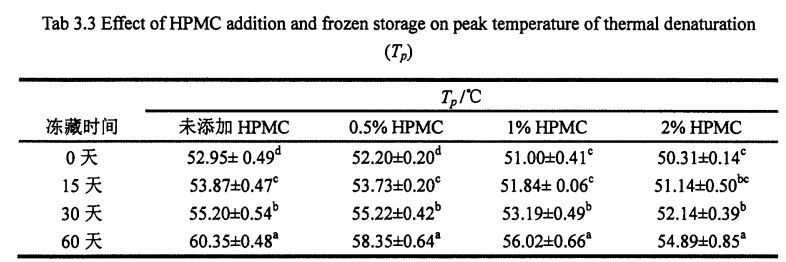
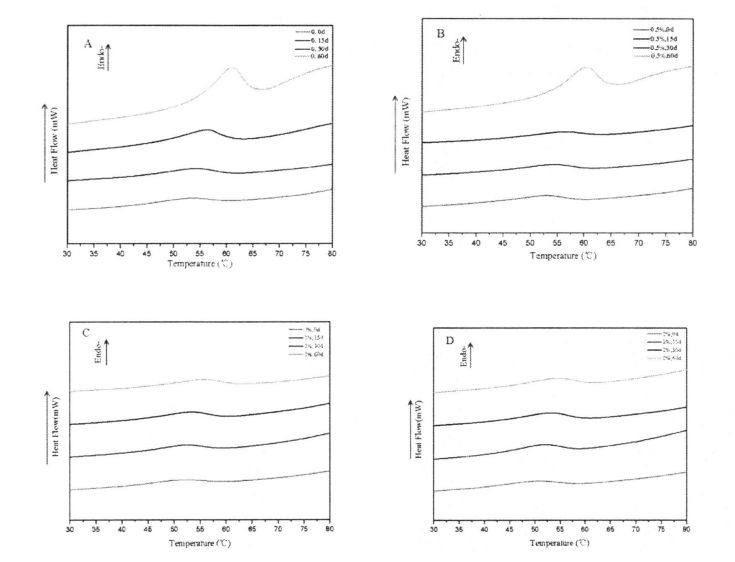
Fig 3.2 Tipaj DSC -termogramoj de glutenaj proteinoj kun 0 % HPMC (A) ; kun O.5 % HPMC (B) ; kun 1 % HPMC (C) ; kun 2 % HPMC (D) post malsama tempo de Frosta Stokado , de 0D ĝis 60D indikita de la plej malalta kurbo ĝis la plej alta en ĉiu en ĉiu en ĉiu en ĉiu en la plej alta kurbo ĝis la plej alta kurbo de 0D ĝis 60D de la plej malalta kurbo de la plej alta tempo de 0D ĝis 60D de la plej alta tempo de 0D ĝis 60D de la plej alta tempo de 0D ĝis 60. Noto: A estas la DSC -kurbo de tritika gluten sen aldoni HPMC; B estas la aldono de O. DSC -kurbo de tritika gluten kun 5% HPMC; C estas la DSC -kurbo de tritika gluten kun 1% HPMC; D estas la DSC-kurbo de tritika gluten kun 2% HPMC 3.3.3 Efikoj de HPMC-aldona kvanto kaj frostiga tempo sur senpaga sulfhidrila enhavo (C-SH) intermolekula kaj intramolekula kovalentaj ligoj estas tre gravaj por la stabileco de pasto-reto-strukturo. Disulfida ligo (-ss-) estas kovalenta ligado formita de dehidrogenado de du senpagaj sulfhidrilaj grupoj (.sh). Glutenino estas kunmetita de glutenino kaj gliadino, la unua povas formi intramolekulajn kaj intermolekulajn disulfidajn ligojn, dum la dua povas formi nur intramolekulajn disulfidajn ligojn [1241] tial disulfidaj ligoj estas intramolekulaj/intermolekulaj disulfidaj ligoj. important way of cross-linking. Compared to adding 0%, O. The C-SH of 5% and 1% HPMC without freezing treatment and the C-SH of gluten after 60 days of freezing have different degrees of increase respectively. Specifically, the face with no HPMC added gluten C. SH increased by 3.74 "mol/g to 8.25 "mol/g, while C.sh, shellfish, with gluten supplemented with 0.5% and 1% HPMC increased by 2.76 "mol/g to 7.25""mol/g and 1.33 "mol/g to 5.66 "mol/g (Fig. 3.3). Zhao, et a1. (2012) found that after 120 days of frozen storage, the content of free thiol groups increased significantly [ 1071. It is worth noting that the C-SH of gluten protein was significantly lower than that of other frozen storage periods when the freezing period was 15 days, which may be attributed to the freezing shrinkage effect of gluten protein structure, which makes the More intermolecular and intramolecular disulfide bonds were locally formed in a shorter freezing time [1161. Wang, et a1. (2014) found that the C-SH of glutenin-rich proteins was also significantly increased after 15 days of freezing. Decreased [1251. However, the gluten protein supplemented with 2% HPMC did not increase significantly except for C-SH, which also decreased significantly at 15 days, with the extension of freezing time.
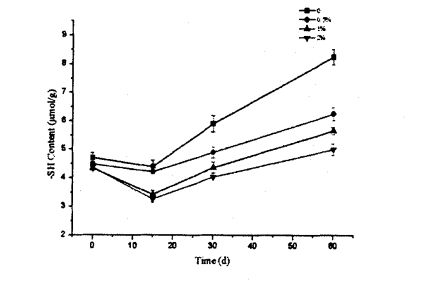
Fig 3.3 Effect of HPMC addition and frozen storage on the content of free-SH for gluten proteins As mentioned above, freezable water can form ice crystals at low temperatures and distribute in the interstices of the gluten network. Therefore, with the prolongation of freezing time, the ice crystals become larger, which squeezes the gluten protein structure more seriously, and leads to the breakage of some intermolecular and intramolecular disulfide bonds, which increases the content of free sulfhydryl groups. On the other hand, the experimental results show that HPMC can protect the disulfide bond from the extrusion damage of ice crystals, thereby inhibiting the depolymerization process of gluten protein. 3.3.4 Efikoj de HPMC -aldona kvanto kaj frostiga stokadotempo sur transversa malstreĉa tempo (T2) de malseka glutena maso La distribuo de transversa malstreĉa tempo (T2) povas reflekti la modelon kaj dinamikan procezon de akva migrado en manĝaj materialoj [6]. Figure 3.4 shows the distribution of wet gluten mass at 0 and 60 days with different HPMC additions, including 4 main distribution intervals, namely 0.1.1 ms (T21), 1.10 ms (T22), 10.100 ms (dead;) and 1 00-1 000 ms (T24). Bosmans et al. (2012) found a similar distribution of wet gluten mass [1261], and they suggested that protons with relaxation times below 10 ms could be classified as rapidly relaxing protons, which are mainly derived from poor mobility the bound water, therefore, may characterize the relaxation time distribution of bound water bound to a small amount of starch, while Dang may characterize the relaxation time distribution of bound water bound to gluten protein. In addition, Kontogiorgos (2007) - t11¨, the "strands" of the gluten protein network structure are composed of several layers (Sheets) about 5 nm apart, and the water contained in these layers is limited water (or Bulk water, phase water), the mobility of this water is between the mobility of bound water and free water. Kaj T23 povas esti atribuita al la malstreĉa tempo -distribuo de restriktita akvo. La T24 -distribuo (> 100 ms) havas longan malstreĉan tempon, do ĝi karakterizas senpagan akvon kun forta movebleco. This water exists in the pores of the network structure, and there is only a weak capillary force with the gluten protein system.
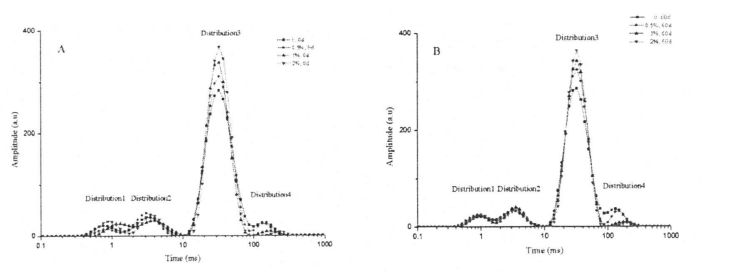
Fig 3.4 Efekto de FIPMC -aldono kaj frosta stokado sur distribuaj kurboj de transversa malstreĉa tempo por gluten -pasto
Comparing the wet gluten doughs with different addition amounts of HPMC stored in frozen storage for 60 days and unfrozen storage respectively, it was found that the total distribution area of T21 and T24 did not show a significant difference, indicating that the addition of HPMC did not significantly increase the relative amount of bound water. content, which may be due to the fact that the main water-binding substances (gluten protein with a small amount of starch) were not significantly changed by the addition of a small amount of HPMC. On the other hand, by comparing the distribution areas of T21 and T24 of wet gluten mass with the same amount of HPMC added for different freezing storage times, there is also no significant difference, which indicates that the bound water is relatively stable during the freezing storage process, and has a negative impact on the environment. Ŝanĝoj estas malpli sentemaj kaj malpli tuŝitaj.
Krome, la alteco kaj areo de la T24 -distribuo de la malseka glutena maso kun malsamaj enhavoj de HPMC estis signife malsamaj (Fig. 3.4, A), kaj la relativa enhavo de libera akvo estis negative korelaciita kun la kvanto de HPMC aldonita. Ĉi tio estas ĝuste la malo de la danĝera distribuo. Therefore, this variation rule indicates that HPMC has water holding capacity and converts free water to confined water. However, after 60 days of freezing, the height and area of T24 distribution increased to varying degrees, which indicated that the water state changed from restricted water to free-flowing state during the freezing process. Ĉi tio estas plejparte pro la ŝanĝo de la konformiga proteino de gluten kaj la detruo de la "tavolo" en la gluten -strukturo, kiu ŝanĝas la staton de la limigita akvo enhavita en ĝi. Kvankam la enhavo de frostigebla akvo determinita de DSC ankaŭ pliiĝas kun la etendo de frostiga stokado, tamen pro la diferenco en la mezuraj metodoj kaj karakterizaj principoj de la du, la frostigebla akvo kaj libera akvo ne estas tute ekvivalentaj. For the wet gluten mass added with 2% HPMC, after 60 days of freezing storage, none of the four distributions showed significant differences, indicating that HPMC can effectively retain the water state due to its own water-holding properties and its interaction with gluten. and stable liquidity.
3.3.5 Efikoj de HPMC -aldona kvanto kaj frostiga stokadotempo sur la malĉefa strukturo de glutena proteino
Ĝenerale, la malĉefa strukturo de proteino estas dividita en kvar specojn, α-spiralon, β-falditajn, β-angulojn kaj hazardajn buklojn. La plej gravaj malĉefaj ligoj por la formado kaj stabiligo de la spaca konformado de proteinoj estas hidrogenaj ligoj. Tial proteina denaturado estas procezo de rompado de hidrogenaj ligoj kaj konformaj ŝanĝoj.
Fourier transform infrared spectroscopy (FT-IR) has been widely used for high-throughput determination of the secondary structure of protein samples. The characteristic bands in the infrared spectrum of proteins mainly include, amide I band (1700.1600 cm-1), amide II band (1600.1500 cm-1) and amide III band (1350.1200 cm-1). Responde, la Amide I-bando La absorba pinto originas de la streĉa vibro de la karbonil-grupo (-c = O-.), La amida II-bando estas ĉefe pro la fleksa vibrado de la amino-grupo (-nh-) [1271], kaj la amido III estas ĉefe pro la amino de la amino de la tempo de la amino de la amino de la amino de la amino de la tempo. vibration, and has a high sensitivity to changes in protein secondary structure [128'1291. Kvankam la supraj tri karakterizaj bandoj estas ĉiuj karakterizaj infraruĝaj absorbaj pintoj de proteinoj, la specifa alivorte, la absorba intenseco de amida II-bando estas pli malalta, do la duonkvanta precizeco de proteina malĉefa strukturo estas malbona; while the peak absorption intensity of amide I band is higher, so many researchers analyze the secondary structure of protein by this band [ 1301, but the absorption peak of water and the amide I band are overlapped at about 1640 cm. 1 wavenumber (Overlapped), which in turn affects the accuracy of the results. Therefore, the interference of water limits the determination of the amide I band in protein secondary structure determination. In this experiment, in order to avoid the interference of water, the relative contents of four secondary structures of gluten protein were obtained by analyzing the amide III band. Peak position (wavenumber interval) of
La atribuo kaj nomado estas listigitaj en Tabelo 3.4.
Langeto 3.4 pintaj pozicioj kaj asigno de malĉefaj strukturoj originis de amida III-bando en FT-IR-spektroj

Figure 3.5 is the infrared spectrum of the amide III band of gluten protein added with different contents of HPMC for 0 days after being frozen for 0 days after deconvolution and fitting of the second derivative. (2001) aplikis la duan derivaĵon por kongrui al la malkonstruitaj pintoj kun similaj pintaj formoj [1321]. In order to quantify the relative content changes of each secondary structure, Table 3.5 summarizes the relative percentage content of the four secondary structures of gluten protein with different freezing times and different HPMC additions (corresponding peak integral area/peak total area).
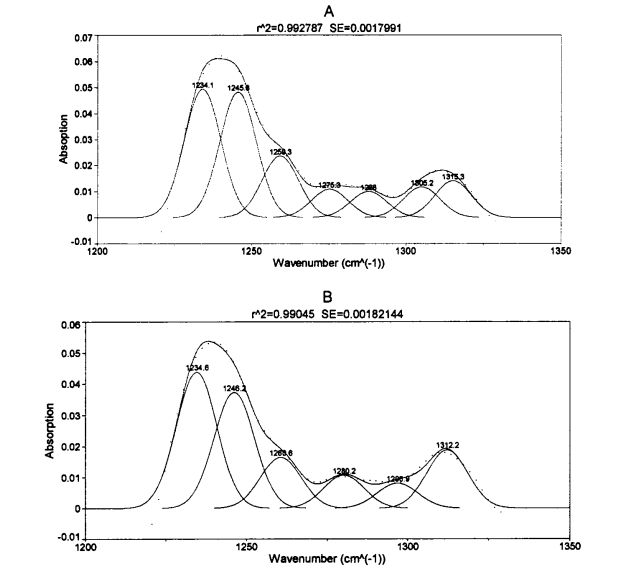
Noto: A estas la infraruĝa spektro de tritika gluten -proteino sen aldoni HPMC dum 0 tagoj da frosta stokado; B estas la infraruĝa spektro de tritika glutena proteino de frosta stokado dum 0 tagoj kun 2% HPMC aldonita
With the prolongation of frozen storage time, the secondary structure of gluten protein with different additions of HPMC changed to different degrees. It can be seen that both frozen storage and addition of HPMC have an effect on the secondary structure of gluten protein. Sendepende de la kvanto de HPMC aldonita, B. La faldita strukturo estas la plej reganta strukturo, respondecante pri ĉirkaŭ 60%. Post 60 tagoj da frosta stokado, aldonu 0%, OB -gluten de 5% kaj 1% HPMC. La relativa enhavo de faldoj pliiĝis signife je 3,66%, 1,87%kaj 1,16%respektive, kiu estis simila al la rezultoj determinitaj de Meziani et al. (2011) [l33J]. However, there was no significant difference during frozen storage for gluten supplemented with 2% HPMC. In addition, when frozen for 0 days, with the increase of HPMC addition, p. The relative content of folds increased slightly, especially when the addition amount was 2%, p. The relative content of folds increased by 2.01%. D. The folded structure can be divided into intermolecular p. Faldado (kaŭzita de agregado de proteinaj molekuloj), kontraŭparalelaj p. Faldita kaj paralela p. Tri substrukturoj estas falditaj, kaj estas malfacile konstati, kiu substrukturo okazas dum la glacia procezo
ŝanĝita. Some researchers believe that the increase in the relative content of the B-type structure will lead to an increase in the rigidity and hydrophobicity of the steric conformation [41], and other researchers believe that p. The increase in folded structure is due to part of the new β-Fold formation is accompanied by a weakening of the structural strength maintained by hydrogen bonding [421]. β- The increase in the folded structure indicates that the protein is polymerized through hydrophobic bonds, which is consistent with the results of the peak temperature of thermal denaturation measured by DSC and the distribution of transverse relaxation time measured by low-field nuclear magnetic resonance. Protein denaturation. Aliflanke, aldonis 0.5%, 1% kaj 2% HPMC-gluten-proteinon α-Whirling. The relative content of helix increased by 0.95%, 4.42% and 2.03% respectively with the prolongation of freezing time, which is consistent with Wang, et a1. (2014) trovis similajn rezultojn [134]. 0 de gluten sen aldonita HPMC. There was no significant change in the relative content of helix during the frozen storage process, but with the increase of the addition amount of freeze for 0 days. Estis signifaj diferencoj en la relativa enhavo de α-Whirling-strukturoj.
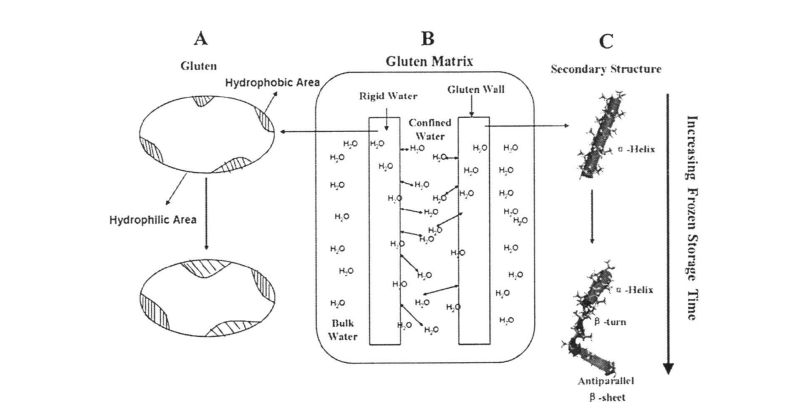
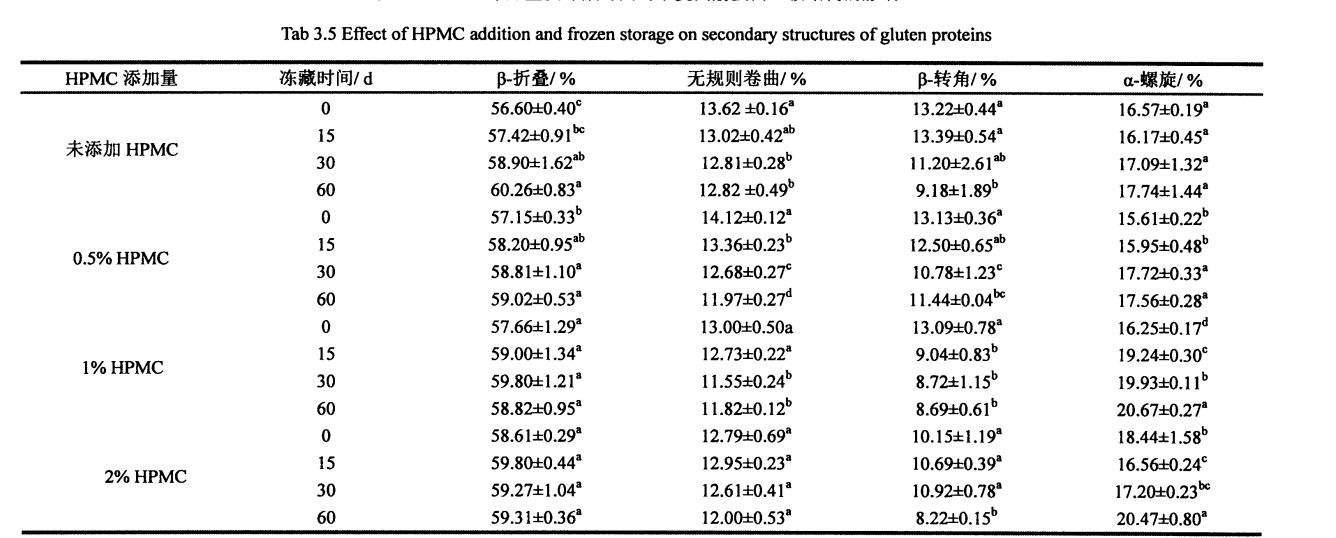
All samples with the extension of freezing time, p. The relative contents of the corners were significantly reduced. This shows that β-turn is very sensitive to freezing treatment [135. 1361], and whether HPMC is added or not has no effect. Wellner, et a1. (2005) proposed that the β-chain turn of gluten protein is related to the β-turn space domain structure of the glutenin polypeptide chain [l 37]. Except that the relative content of random coil structure of gluten protein added with 2% HPMC had no significant change in frozen storage, the other samples were significantly reduced, which may be caused by the extrusion of ice crystals. Krome, kiam frostigitaj dum 0 tagoj, la relativa enhavo de α-helico, β-folio kaj β-turna strukturo de gluten-proteino aldonita kun 2% HPMC signife diferencis de tiuj de gluten-proteino sen HPMC. Ĉi tio eble indikas, ke ekzistas interago inter HPMC kaj gluten -proteino, formante novajn hidrogenajn ligojn kaj poste influas la konformadon de la proteino; or HPMC absorbs the water in the pore cavity of the protein space structure, which deforms the protein and leads to more changes between the subunits. close. The increase of the relative content of β-sheet structure and the decrease of the relative content of β-turn and α-helix structure are consistent with the above speculation. During the freezing process, the diffusion and migration of water and the formation of ice crystals destroy the hydrogen bonds that maintain the conformational stability and expose the hydrophobic groups of proteins. Krome, el la perspektivo de energio, ju pli malgranda estas la energio de la proteino, des pli stabila ĝi estas. At low temperature, the self-organization behavior (folding and unfolding) of protein molecules proceeds spontaneously and leads to conformational changes.

Noto: En la sama vico, ekzistas SuperScript -litero kun neniu M kaj B, indikante ke estas grava diferenco (<0.05);
After 60 days of frozen storage, add 0%, O. The surface hydrophobicity of gluten with 5%, 1% and 2% HPMC increased by 70.53%, 55.63%, 43.97% and 36.69%, respectively (Table 3.6). In particular, the surface hydrophobicity of the gluten protein without adding HPMC after being frozen for 30 days has increased significantly (P<0.05), and it is already greater than the surface of the gluten protein with 1% and 2% HPMC added after freezing for 60 days Hydrophobicity. Samtempe, post 60 tagoj da frosta stokado, la surfaca hidrofobiceco de gluten -proteino aldonita kun malsamaj enhavoj montris signifajn diferencojn. Tamen, post 60 tagoj da frostita stokado, la surfaca hidrofobiceco de gluten -proteino aldonita kun 2% HPMC nur pliiĝis de 19.749 ĝis 26.995, kio ne signife diferencis de la surfaca hidrofobiceco post 30 tagoj de frosta stokado, kaj estis ĉiam pli malalta ol aliaj la valoro de la surfaca hidrofobeco de la specimeno. This indicates that HPMC can inhibit the denaturation of gluten protein, which is consistent with the results of DSC determination of the peak temperature of heat deformation. This is because HPMC can inhibit the destruction of protein structure by recrystallization, and due to its hydrophilicity,
3.3.7 Efikoj de HPMC-aldona kvanto kaj frostiga stokadotempo sur la mikro-reta strukturo de gluten
The continuous gluten network structure contains many pores to maintain the carbon dioxide gas produced by the yeast during the proofing process of the dough. Therefore, the strength and stability of the gluten network structure are very important to the quality of the final product, such as specific volume, quality, etc. Structure and sensory assessment. De mikroskopa vidpunkto, la surfaca morfologio de la materialo povas esti observata per skanado de elektronika mikroskopio, kiu donas praktikan bazon por la ŝanĝo de la gluten -reto -strukturo dum la glacia procezo.
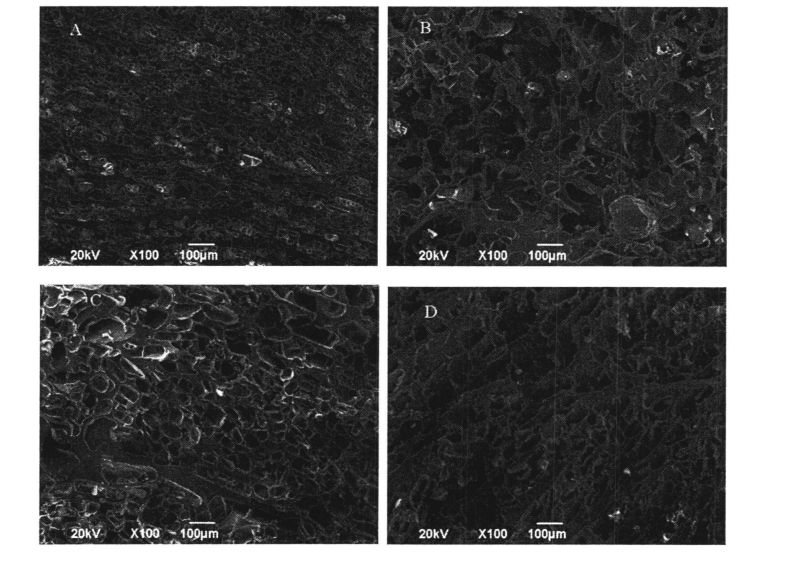
Note: A is the microstructure of gluten network without adding HPMC and frozen for 0 days; B estas la mikrostrukturo de gluten -reto sen aldono de HPMC kaj frostita dum 60 tagoj; C is the microstructure of gluten network with 2% HPMC added and frozen for 0 days :D is the gluten network microstructure with 2% HPMC added and frozen for 60 days
Small approximate porous sponge-like morphology. However, after 60 days of frozen storage, the cells in the gluten microstructure without HPMC became larger in size, irregular in shape, and unevenly distributed (Fig. 3.7, A, B), mainly due to the This is caused by the fracture of the "wall", which is consistent with the measurement results of the free thiol group content, that is, during the freezing process, the ice crystal squeezes and breaks the disulfide bond, which affects the strength and integrity of the structure. As reported by Kontogiorgos & Goff (2006) and Kontogiorgos (2007), the interstitial regions of the gluten network are squeezed due to freeze-shrinkage, resulting in structural disruption [138. 1391]. In addition, due to dehydration and condensation, a relatively dense fibrous structure was produced in the spongy structure, which may be the reason for the decrease in free thiol content after 15 days of frozen storage, because more disulfide bonds were generated and frozen storage. The gluten structure was not severely damaged for a shorter time, which is consistent with Wang, et a1. (2014) observed similar phenomena [134]. At the same time, the destruction of the gluten microstructure leads to freer water migration and redistribution, which is consistent with the results of low-field time-domain nuclear magnetic resonance (TD-NMR) measurements. Some studies [140, 105] reported that after several freeze-thaw cycles, the gelatinization of rice starch and the structural strength of the dough became weaker, and the water mobility became higher. Tamen, post 60 tagoj da frosta stokado, la mikrostrukturo de gluten kun 2% HPMC -aldono ŝanĝiĝis malpli, kun pli malgrandaj ĉeloj kaj pli regulaj formoj ol gluten sen HPMC -aldono (Fig. 3.7, B, D). Ĉi tio plue indikas, ke HPMC povas efike malhelpi la detruon de gluten -strukturo per rekristaligo.
Ĉapitro 4 Efikoj de HPMC -aldono sur la strukturo kaj ecoj de amelo sub frosta stokado
4.1 Enkonduko
Starch is a chain polysaccharide with glucose as the monomer. key) two types. From a microscopic point of view, starch is usually granular, and the particle size of wheat starch is mainly distributed in two ranges of 2-10 pro (B starch) and 25-35 pm (A starch). From the perspective of crystal structure, starch granules include crystalline regions and amorphous regions (je, non-crystalline regions), and the crystal forms are further divided into A, B, and C types (it becomes V-type after complete gelatinization). Ĝenerale, la kristala regiono konsistas el amilopektino kaj la amorfa regiono konsistas ĉefe el amilozo. This is because, in addition to the C chain (main chain), amylopectin also has side chains composed of B (Branch Chain) and C (Carbon Chain) chains, which makes amylopectin appear "tree-like" in raw starch. The shape of the crystallite bundle is arranged in a certain way to form a crystal.
Among them, starch gelatinization refers to the process in which starch granules are gradually disintegrated and hydrated in a system with high water content and under heating conditions. Ĝi povas esti proksimume dividita en tri ĉefajn procezojn. 1) revertebla akva absorba stadio; Antaŭ ol atingi la komencan temperaturon de gelatinigo, la amelo -granuloj en la amelo -suspendo (slurry) tenas sian unikan strukturon senŝanĝa, kaj la ekstera formo kaj interna strukturo esence ne ŝanĝiĝas. Nur tre malmulta solvebla amelo estas dissemita en la akvo kaj povas esti restarigita al ĝia originala stato. 2) The irreversible water absorption stage; Kiam la temperaturo pliiĝas, akvo eniras la interspacon inter la amelo -kristalitaj pakaĵoj, nerekteble absorbas grandan kvanton da akvo, kaŭzante la amelon ŝveli, la volumo disetendiĝas plurajn fojojn, kaj la hidrogenaj ligoj inter la amelo -molekuloj rompiĝas. It becomes stretched and the crystals disappear. At the same time, the birefringence phenomenon of starch, that is, the Maltese Cross observed under a polarizing microscope, begins to disappear, and the temperature at this time is called the initial gelatinization temperature of starch. 3) Starch -granula malintegriĝa stadio; starch molecules completely enter the solution system to form starch paste (Paste/Starch Gel), at this time the viscosity of the system is the largest, and the birefringence phenomenon completely disappears, and the temperature at this time is called the complete starch gelatinization temperature, the gelatinized starch is also called α-starch [141]. When the dough is cooked, the gelatinization of starch endows the food with its unique texture, flavor, taste, color, and processing characteristics.
Many studies have shown that the gel strength of starch paste decreases, it is easy to age, and its quality deteriorates under the condition of freezing storage, such as Canet, et a1. (2005) studied the effect of freezing temperature on the quality of potato starch puree; Ferrero, et a1. (1993) esploris la efikojn de glacia rapideco kaj malsamaj specoj de aldonaĵoj sur la ecoj de tritiko kaj maizo-amelo-pastoj [151-156]. However, there are relatively few reports on the effect of frozen storage on the structure and properties of starch granules (native starch), which needs to be further explored. Frosta pasto (ekskludante antaŭ-kuiritan frostan paston) estas en la formo de neglatinigitaj granuloj sub la kondiĉo de frosta stokado. Therefore, studying the structure and structural changes of native starch by adding HPMC has a certain effect on improving the processing properties of frozen dough. significance.
4.2 Eksperimentaj Materialoj kaj Metodoj
Tritika amelo Binzhou Zhongyu Food Co., Ltd.; HPMC Aladdin (Shanghai) Chemical Reagent Co., Ltd.;
HH Cifereca Konstanta Temperatura Akva Bano
BC/BD-272SC-fridujo
SX2.4.10 Muffle Furnace
DHG. 9070A eksplodiga seka forno
KDC. 160h-altrapida fridigita centrifugilo
Malkovro R3 Rotacia Reometro
SX2.4.10 Muffle Furnace
Fabrikisto
Sartorius, Germanio
Hefei Meiling Co., Ltd.
Rigaku Manufacturing Co., Ltd.
4.2.3 Eksperimenta Metodo
Pezu 1 g da amelo, aldonu 9 ml da distilita akvo, plene skuu kaj miksi por prepari 10% (p/p) amelan suspendon. Poste metu la ekzemplan solvon. 18 ℃ refrigerator, frozen storage for 0, 15 d, 30 d, 60 d, of which 0 day is the fresh control. Add 0.5%, 1%, 2% (w/w) HPMC instead of the corresponding quality starch to prepare samples with different addition amounts, and the rest of the treatment methods remain unchanged.
4.2.3.2 Reologiaj Propraĵoj
(1) amelo -gelatinigaj trajtoj
En ĉi tiu eksperimento, reometro estis uzata anstataŭ rapida viscometer por mezuri la gelatenajn trajtojn de amelo. Vidu Bae et a1. (2014) method [1571] with slight modifications. The specific program parameters are set as follows: use a plate with a diameter of 40 mill, the gap (gap) is 1000 mm, and the rotation speed is 5 rad/s; I) incubate at 50 °C for 1 min; ii) je la 5a c/min varmigita ĝis 95 ° C; iii) kept at 95°C for 2.5 min, iv) then cooled to 50°C at 5°C/min; v) lastly held at 50°C for 5 min.
Draw 1.5 mL of sample solution and add it to the center of the rheometer sample stage, measure the gelatinization properties of the sample according to the above program parameters, and obtain the time (min) as the abscissa, the viscosity (Pa s) and the temperature (°C) as the starch gelatinization curve of the ordinate. Laŭ GB/T 14490.2008 [158], la respondaj gelatinigaj karakterizaj indikiloj - gelatiniza pinta viskozeco (kampo), maksimuma temperaturo (ANG), minimuma viskozeco (alta), fina viskozeco (proporcio) kaj dekadenca valoro (rompo) estas akiritaj. Valoro, bv) kaj regenerado -valoro (Malkaŝa valoro, sv), kie, kaduka valoro = maksimuma viskozeco - minimuma viskozeco; Funkciiga valoro = fina viskozeco - minimuma viskozeco. Ĉiu specimeno estis ripetita tri fojojn.
(2) konstanta fluo -testo de amelo -pasto
The above gelatinized starch paste was subjected to the Steady Flow Test, according to the method of Achayuthakan & Suphantharika [1591, the parameters were set to: Flow Sweep mode, stand at 25°C for 10 min, and the shear rate scan range was 1) 0.1 S one. 100s ~, 2) 100s ~. 0.1 S~, the data is collected in logarithmic mode, and 10 data points (plots) are recorded every 10 times the shear rate, and finally the shear rate (Shear Rate, SI) is taken as the abscissa, and the shear viscosity ( Viscosity, pa ·s) is the rheological curve of the ordinate. Use Origin 8.0 to perform nonlinear fitting of this curve and obtain the relevant parameters of the equation, and the equation satisfies the power law (Power Law), that is, t/=K), nI, where M is the shear viscosity (pa ·s), K is the consistency coefficient (Pa ·s), is the shear rate (s. 1), and n is the flow behavior index (Flow Behavior Index, dimensionless).
Take 2.5 g of amyloid and mix it with distilled water in a ratio of 1:2 to make starch milk. Frostiĝu je 18 ° C dum 15 d, 30 d, kaj 60 d. Add 0.5, 1, 2% HPMC (w/w) to replace starch of the same quality, and other preparation methods remain unchanged. After the freezing treatment is completed, take it out, equilibrate at 4 °C for 4 h, and then thaw at room temperature until it is tested.
(3) amelo -ĝela forto (ĝela forto)
After the corresponding freezing treatment time, the samples were taken out, thawed completely, and dried in an oven at 40 °C for 48 h. Finally, it was ground through a 100-mesh sieve to obtain a solid powder sample for use (suitable for XRD testing). See Xie, et a1. (2014) method for sample preparation and determination of thermodynamic properties '1611, weigh 10 mg of starch sample into a liquid aluminum crucible with an ultra-micro analytical balance, add 20 mg of distilled water in a ratio of 1:2, press and seal it and place it at 4 °C In the refrigerator, equilibrated for 24 h. Frostiĝu je 18 ° C (0, 15, 30 kaj 60 tagoj). Aldonu 0,5%, 1%, 2%(p/p) HPMC por anstataŭigi la respondan kvaliton de amelo, kaj aliaj preparaj metodoj restas senŝanĝaj. After the freezing storage time is over, take out the crucible and equilibrate at 4 °C for 4 h.
(3) Determino de gelatiniza temperaturo kaj entalpia ŝanĝo
4.2.3.6 Determino de amelo ŝvela potenco
Take 0.1 g of the dried, ground and sieved amyloid into a 50 mL centrifuge tube, add 10 mL of distilled water to it, shake it well, let it stand for 0.5 h, and then place it in a 95°C water bath at a constant temperature. Post 30 min, post kiam gelatinizado finiĝos, elprenu la centrifugan tubon kaj metu ĝin en glacia bano dum 10 minutoj por rapida malvarmigo. Fine, centrifugu je 5000 rpm dum 20 min, kaj elverŝu la supernatanton por akiri precipitaĵon. Ŝvela potenco = precipita maso/specimena maso [163].
4.2.3.7 Datuma Analizo kaj Prilaborado
4.3 Analizo kaj Diskuto
According to GB 50093.2010, GB/T 5009.9.2008, GB 50094.2010 (78-s0), the basic components of wheat starch - moisture, amylose/amylopectin and ash content were determined. La rezultoj estas montritaj en Tabelo 4. 1 Montrita.

La amelo -suspendo kun certa koncentriĝo estas varmigita je certa hejtada rapideco por fari la amelon gelatinigitan. After starting to gelatinize, the turbid liquid gradually becomes pasty due to the expansion of starch, and the viscosity increases continuously. Subsequently, the starch granules rupture and the viscosity decreases. When the paste is cooled at a certain cooling rate, the paste will gel, and the viscosity value will further increase. La viskozeca valoro kiam ĝi estas malvarmetigita ĝis 50 ° C estas la fina viskozeca valoro (Figuro 4.1).
On the other hand, when the amount of HPMC added was the same, the peak viscosity, minimum viscosity, final viscosity, decay value and retrogradation value of starch gelatinization increased significantly with the extension of freezing storage time. Specifically, the peak viscosity of starch suspension without adding HPMC increased from 727.66±90.70 CP (frozen storage for 0 days) to 1584.44+68.11 CP (frozen storage for 60 days); adding 0.5 The peak viscosity of starch suspension with %HPMC increased from 758.514-48.12 CP (freezing for 0 days) to 1415.834-45.77 CP (freezing for 60 days); starch suspension with 1% HPMC added The peak viscosity of the starch liquid increased from 809.754-56.59 CP (freeze storage for 0 days) to 1298.19-±78.13 CP (frozen storage for 60 days); while the starch suspension with 2% HPMC CP added Gelatinization peak viscosity from 946.64 ± 9.63 CP (0 days frozen) increased to 1240.224-94.06 CP (60 days frozen). At the same time, the lowest viscosity of starch suspension without HPMC was increased from 391.02-41 8.97 CP (freezing for 0 days) to 556.77±29.39 CP (freezing for 60 days); adding 0.5 The minimum viscosity of the starch suspension with %HPMC increased from 454.954-36.90 CP (freezing for 0 days) to 581.934-72.22 CP (freezing for 60 days); La amelo-suspendo kun 1% HPMC aldonis la minimuman viskozecon de la likvaĵo pliigita de 485.564-54.05 CP (glaciaĵo dum 0 tagoj) al 625.484-67.17 CP (frostiĝi dum 60 tagoj); Dum la amelo-suspendo aldonis 2% HPMC CP gelatinizintan la plej malaltan viskozecon pliiĝis de 553.034-55.57 CP (0 tagoj frostigitaj) al 682.58 ± 20.29 CP (60 tagoj frostita).

(Frosta stokado dum 0 tagoj) pliiĝis al 1198,09 ± 41,15 CP (frosta stokado dum 60 tagoj). Correspondingly, the attenuation value of starch suspension without adding HPMC increased from 336.64 ± 71.73 CP (frozen storage for 0 days) to 1027.67 ± 38.72 CP (frozen storage for 60 days); Aldonante 0,5 la mildigan valoron de amelo -suspendo kun %HPMC pliiĝis de 303,56 ± 11,22 CP (frosta stokado dum 0 tagoj) al 833,9 ± 26,45 CP (frosta stokado dum 60 tagoj); Suspendo de amelo kun 1% HPMC aldonis la mildigan valoron de la likvaĵo estis pliigita de 324,19 ± 2,54 CP (glaciaĵo dum 0 tagoj) al 672,71 ± 10,96 CP (frostigado dum 60 tagoj); Aldonante 2% HPMC , la mildiga valoro de la amelo -suspendo pliiĝis de 393,61 ± 45,94 CP (glaciaĵo dum 0 tagoj) al 557,64 ± 73,77 CP (frostigado dum 60 tagoj); while the starch suspension without HPMC added The retrogradation value increased from 403.60 ± 6.13 C
P (frosta stokado dum 0 tagoj) ĝis 856,38 ± 16,20 CP (frosta stokado dum 60 tagoj); the retrogradation value of starch suspension added with 0.5% HPMC increased from 427 .29±14.50 CP (frozen storage for 0 days) increased to 740.93±35.99 CP (frozen storage for 60 days); La retrograda valoro de amelo -suspendo aldonita kun 1% HPMC pliiĝis de 360,48 ± 41. 39 CP (frosta stokado dum 0 tagoj) pliiĝis al 666,46 ± 21,40 CP (frosta stokado dum 60 tagoj); dum la retrograda valoro de amelo -suspendo aldonita kun 2% HPMC pliiĝis de 357,85 ± 21,00 CP (frosta stokado dum 60 tagoj). 0 tagoj) pliiĝis al 515,51 ± 20,86 CP (60 tagoj frostigitaj).
It can be seen that with the prolongation of freezing storage time, the starch gelatinization characteristics index increased, which is consistent with Tao et a1. f2015) 1. Consistent with the experimental results, they found that with the increase of the number of freeze-thaw cycles, the peak viscosity, minimum viscosity, final viscosity, decay value, and retrogradation value of starch gelatinization all increased to different degrees [166J]. This is mainly because in the process of freezing storage, the amorphous region (Amorphous Region) of starch granules is destroyed by ice crystallization, so that the amylose (the main component) in the amorphous region (non-crystalline region) undergoes phase separation (Phase. separated) phenomenon, and dispersed in the starch suspension, resulting in an increase in the viscosity of starch gelatinizado, kaj pliigo de la rilata atenua valoro kaj retrograda valoro. Tamen la aldono de HPMC malhelpis la efikon de glacia kristaliĝo sur amelo -strukturo. Sekve, la maksimuma viskozeco, minimuma viskozeco, fina viskozeco, dekadenca valoro kaj retrograda indico de amelo -gelatinigo pliiĝis kun la aldono de HPMC dum frosta stokado. pliigi kaj malpliiĝi sinsekve.

4.3.3 Efikoj de HPMC -aldona kvanto kaj frosta stokadotempo sur la tondado de amelo -pasto


It can be seen from Table 4.3 that all the flow characteristic indices, 2, are less than 1. Therefore, starch paste (whether HPMC is added or whether it is frozen or not) belongs to Pseudoplastic Fluid, and all show shearing Thinning phenomenon (as the shear rate increases, the shear viscosity of the fluid decreases). Krome, la skanado de tondado estis de 0,1 s respektive. 1 pliiĝis al 100 s ~, kaj tiam malpliiĝis de 100 SD al O. La reologiaj kurboj akiritaj je 1 SD ne tute interkovriĝas, kaj la taŭgaj rezultoj de K, s ankaŭ diferencas, do la amelo -pasto estas tixotropa pseŭdoplasta fluido (ĉu HPMC estas aldonita aŭ ĉu ĝi estas frosta aŭ ne). Tamen, sub la sama frostiga stokado, kun la pliigo de HPMC -aldono, la diferenco inter la taŭgaj rezultoj de la K N -valoroj de la du skanoj iom post iom malpliiĝis, kio indikas, ke la aldono de HPMC igas la strukturon de amelo -pasto sub tondado. It remains relatively stable under the action and reduces the "thixotropic ring"
(Thixotropic Loop) areo, kiu similas al Temsiripong, et a1. (2005) raportis la saman konkludon [167]. This may be mainly because HPMC can form intermolecular cross-links with gelatinized starch chains (mainly amylose chains), which "bound" the separation of amylose and amylopectin under the action of shearing force. , so as to maintain the relative stability and uniformity of the structure (Figure 4.2, the curve with shear rate as abscissa and shear stress as ordinate).
On the other hand, for the starch without frozen storage, its K value decreased significantly with the addition of HPMC, from 78.240±1.661 Pa ·sn (without adding HPMC) to 65.240±1.661 Pa ·sn (without adding HPMC), respectively. 683 ± 1.035 PA · SN (aldonu 0.5% manan MC), 43.122 ± 1.047 PA · SN (aldonu 1% HPMC), kaj 13.926 ± 0.330PA · SN (aldonu 2% HPMC), dum la N -valoro pliiĝis signife, de 0.277 ± 0.011 (sen aldono de HPM) al 0.27 ± 0.011 (sen aldono HPM) al 0.27 ± 0.011 (sen aldono de HPM), de 0.27 ± 0.011 (sen aldono de HPM). 310 ± 0.009 (add 0.5% HPMC), O. 323 ± 0.013 (add 1% HPMC) and O. 43 1 ± 0.0 1 3 (adding 2% HPMC), which is similar to the experimental results of Techawipharat, Suphantharika, & BeMiller (2008) and Turabi, Sumnu, & Sahin (2008), and the increase of n value shows that the addition of HPMC makes the fluid has a tendency to change from pseudoplastic to Newtonian [168'1691]. at the same time, For the starch stored frozen for 60 days, the K, n values showed the same change rule with the increase of HPMC addition.
Tamen, kun la plilongigo de frostiga stokado, la valoroj de K kaj N pliiĝis al malsamaj gradoj, inter kiuj la valoro de K pliiĝis de 78.240 ± 1.661 PA · SN (neadigita, 0 tagoj) al 95.570 ± 1, respektive. 2.421 PA · SN (neniu aldono, 60 tagoj), pliigita de 65.683 ± 1.035 PA · s N (aldono de O. 5% HPMC, 0 tagoj) al 51.384 ± 1.350 PA · s N (aldonu al 0.5% HPMC, 60 tagoj), pliigita de 43.122 ± 1.047 PA · SN (SN (pli ol 43.13. · SN (aldonante 1% HPMC, 60 tagojn)), kaj pliiĝis de 13.926 ± 0.330 PA · SN (aldonante 2% HPMC, 0 tagojn) al 16.064 ± 0.465 PA · SN (aldonante 2% HPMC, 60 tagojn); 0.277 ± 0.011 (without adding HPMC, 0 days) rose to O. 334±0.014 (no addition, 60 days), increased from 0.310±0.009 (0.5% HPMC added, 0 day) to 0.336±0.014 (0.5% HPMC added, 60 days), from 0.323 ± 0.013 (add 1% HPMC, 0 days) to 0.340 ± 0.013 (add 1% HPMC, 60 days), and from 0.431 ± 0.013 (add 1% HPMC, 60 days) 2% HPMC, 0 days) to 0.404+0.020 (add 2% HPMC, 60 days). By comparison, it can be found that with the increase of the addition amount of HPMC, the change rate of K and Knife value decreases successively, which shows that the addition of HPMC can make the starch paste stable under the action of shearing force, which is consistent with the measurement results of starch gelatinization characteristics. konsekvenca.

Fig 4.3 Efekto de HPMC -aldono kaj frosta stokado sur elasta kaj viskoza modulo de amelo -pasto
Note: A is the change of viscoelasticity of unadded HPMC starch with the extension of freezing storage time; B estas la aldono de O. La ŝanĝo de viscoelasteco de 5% HPMC -amelo kun la etendo de frostiga stokado; C estas la ŝanĝo de la viscoelasteco de 1% HPMC -amelo kun la etendo de frostiga stokado; D estas la ŝanĝo de la viscoelasteco de 2% HPMC -amelo kun la etendo de frostiga stokado
The starch gelatinization process is accompanied by the disintegration of starch granules, the disappearance of the crystalline region, and the hydrogen bonding between starch chains and moisture, the starch gelatinized to form a heat-induced (Heat. induced) gel with a certain gel strength. Kiel montrite en Figuro 4.3, por amelo sen frosta stokado, kun la kresko de HPMC -aldono, la G 'de amelo malpliiĝis signife, dum G "havis neniun signifan diferencon, kaj Tan 6 pliiĝis (likvaĵo. 1ike), kio montras, ke dum la proceso de gelatinigo, HPM interagas kun la akva malpliiĝo de HPMC, la aldono de HPM, la aldono. Chaisawang & Suphantharika (2005) trovis ke, aldonante guar -gumon kaj Xanthan -gumon al tapioca amelo, la g 'de la amelo -pasto ankaŭ malpliiĝis [170]. starch granules is separated to form damaged starch (Damaged Starch), which reduces the degree of intermolecular cross-linking after starch gelatinization and the degree of cross-linking after cross-linking. Stability and compactness, and the physical extrusion of ice crystals makes the arrangement of "micelles" (microcrystalline structures, mainly composed of amylopectin) in the starch crystallization area more compact, increasing the relative crystallinity of starch, and at the same time , resulting in insufficient combination of molecular chain and water after starch gelatinization, low extension of molecular chain (molecular chain mobility), and finally caused the gel strength of starch to decline. However, with the increase of HPMC addition, the decreasing trend of G' was suppressed, and this effect was positively correlated with the addition of HPMC. This indicated that the addition of HPMC could effectively inhibit the effect of ice crystals on the structure and properties of starch under frozen storage conditions.
La ŝvela proporcio de amelo povas reflekti la grandecon de amelo -gelatinizado kaj akvo ŝvelaĵo, kaj la stabilecon de amelo -pasto sub centrifugaj kondiĉoj. Kiel montrite en Figuro 4.4, por amelo sen frosta stokado, kun la kresko de HPMC -aldono, la ŝvela forto de amelo pliiĝis de 8.969+0.099 (sen aldoni HPMC) al 9.282- -L0.069 (aldonante 2% HPMC), kio montras, ke la aldono de la ŝvelaĵo de HPMC, kiu konformas al la ŝvebado de la ŝvelaĵo de HPMC, kiu konformas al la ŝvelaĵo de HPPM, kiu konformas al la ŝvelaĵo de la ŝvelaĵo, kiu konformas al la ŝvelaĵo de la ŝvelaĵo, kiu konformas al la ŝvelaĵo, kiu konformas al la ŝvelaĵo, kiu montras, ke la ŝvelaĵo de la ŝvelaĵo de HPM. gelatinization characteristics. However, with the extension of frozen storage time, the swelling power of starch decreased. Compared with 0 days of frozen storage, the swelling power of starch decreased from 8.969-a:0.099 to 7.057+0 after frozen storage for 60 days, respectively. .007 (no HPMC added), reduced from 9.007+0.147 to 7.269-4-0.038 (with O.5% HPMC added), reduced from 9.284+0.157 to 7.777 +0.014 (adding 1% HPMC), reduced from 9.282+0.069 to 8.064+0.004 (adding 2% HPMC). The results showed that the starch granules were damaged after freezing storage, resulting in the precipitation of part of the soluble starch and centrifugation. Tial la solvebleco de amelo pliiĝis kaj la ŝvela potenco malpliiĝis. Krome, post frostiga stokado, amelo gelatinigita amelo -pasto, ĝia stabileco kaj akva tenanta kapacito malpliiĝis, kaj la kombinita ago de la du reduktis la ŝvelan potencon de amelo [1711]. Aliflanke, kun la kresko de HPMC -aldono, la malkresko de amelo ŝvela potenco iom post iom malpliiĝis, indikante ke HPMC povas redukti la kvanton de damaĝita amelo formita dum frostiga stokado kaj malhelpi la gradon de amelo -granula damaĝo.
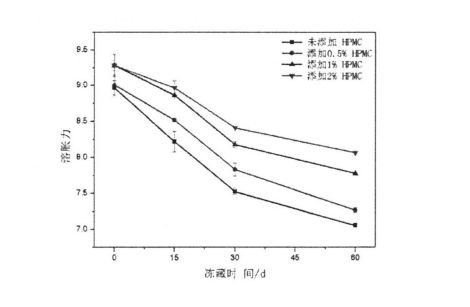
Fig 4.4 Efekto de HPMC -aldono kaj frosta stokado sur ŝvela potenco de amelo
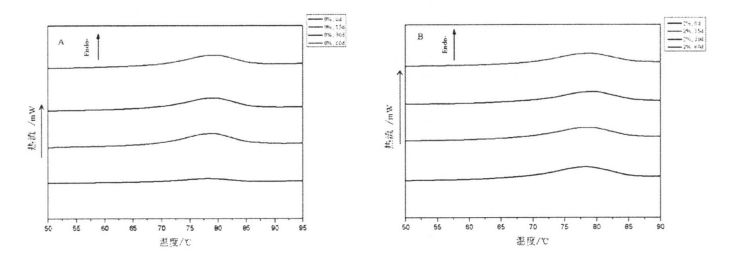
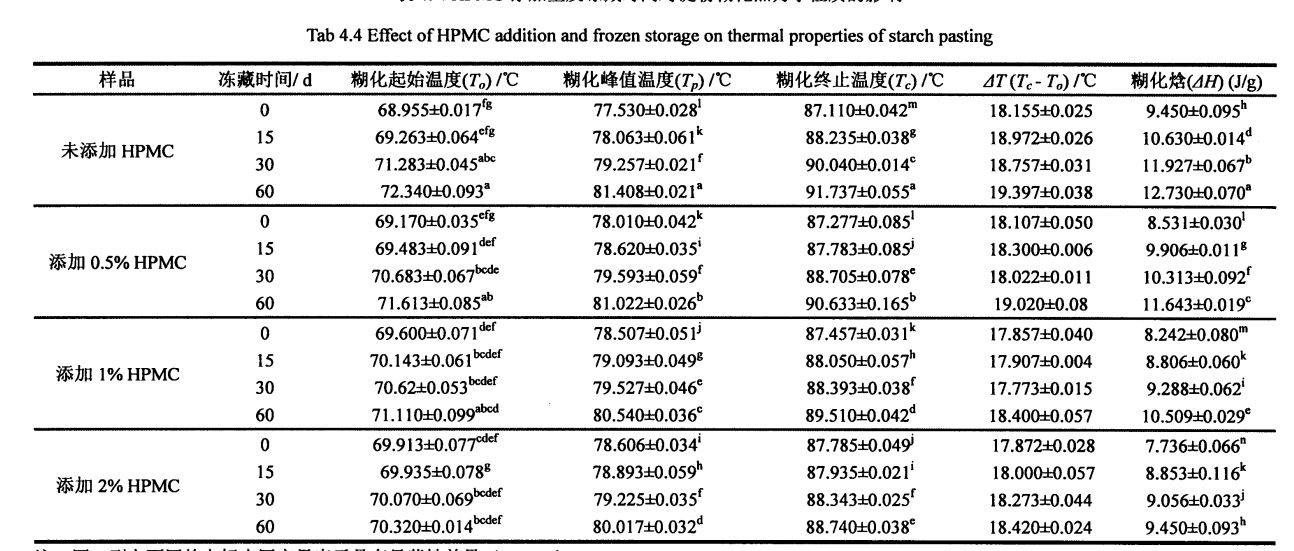
As shown in Table 4.4, for fresh amyloid, with the increase of HPMC addition, starch L has no significant difference, but increases significantly, from 77.530 ± 0.028 (without adding HPMC) to 78.010 ± 0.042 (add 0.5% HPMC), 78.507 ± 0.051 (add 1% HPMC), and 78.606 ± 0.034 (add 2% HPMC), but 4H is significant Decrease, from 9.450 ± 0.095 (without adding HPMC) to 8.53 ± 0.030 (adding 0.5% HPMC), 8.242A: 0.080 (adding 1% HPMC) and 7 .736 ± 0.066 (add 2% HPMC). This is similar to Zhou, et a1. (2008) found that adding a hydrophilic colloid decreased the starch gelatinization enthalpy and increased the starch gelatinization peak temperature [172]. This is mainly because HPMC has better hydrophilicity and is easier to combine with water than starch. At the same time, due to the large temperature range of the thermally accelerated gelation process of HPMC, the addition of HPMC increases the peak gelatinization temperature of starch, while the gelatinization Enthalpy decreases.
On the other hand, starch gelatinization To, T p, Tc, △T and △Hall increased with the extension of freezing time. Specifically, starch gelatinization with 1% or 2% HPMC added had no significant difference after freezing for 60 days, while starch without or with 0.5% HPMC was added from 68.955±0.01 7 (frozen storage for 0 days) increased to 72.340 ± 0.093 (frozen storage for 60 days), and from 69.170 ± 0.035 (frozen storage for 0 days) to 71.613 ± 0.085 (frozen storage for 0 days) 60 days); after 60 days of frozen storage, the growth rate of starch gelatinization decreased with the increase of HPMC addition, such as starch without HPMC added from 77.530 ± 0.028 (frozen storage for 0 days) to 81.028. 408 ± 0.021 (frozen storage for 60 days), while the starch added with 2% HPMC increased from 78.606 ± 0.034 (frozen storage for 0 days) to 80.017 ± 0.032 (frozen storage for 60 days). tagoj); in addition, ΔH also showed the same change rule, which increased from 9.450 ± 0.095 (no addition, 0 days) to 12.730 ± 0.070 (no addition, 60 days), respectively, from 8.450 ± 0.095 (no addition, 0 days) to 12.730 ± 0.070 (no addition, 60 days), respectively. 531 ± 0.030 (add 0.5%, 0 days) to 11.643 ± 0.019 (add 0.5%, 60 days), from 8.242 ± 0.080 (add 1%, 0 days) to 10.509 ± 0.029 (add 1%, 60 days), and from 7.736 ± O. 066 (2% addition, 0 days) rose to 9.450 ± 0.093 (2% addition, 60 days). The main reasons for the above-mentioned changes in the thermodynamic properties of starch gelatinization during the frozen storage process are the formation of damaged starch, which destroys the amorphous region (amorphous region) and increases the crystallinity of the crystalline region. The coexistence of the two increases the relative crystallinity of starch, which in turn leads to an increase in thermodynamic indexes such as starch gelatinization peak temperature and gelatinization enthalpy. However, through comparison, it can be found that under the same freezing storage time, with the increase of HPMC addition, the increase of starch gelatinization To, T p, Tc, ΔT and ΔH gradually decreases. It can be seen that the addition of HPMC can effectively maintain the relative stability of the starch crystal structure, thereby inhibiting the increase of the thermodynamic properties of starch gelatinization.
Figure 4.6. As shown in A, the positions of the starch crystallization peaks are located at 170, 180, 190 and 230, respectively, and there is no significant change in the peak positions regardless of whether they are treated by freezing or adding HPMC. Ĉi tio montras, ke kiel intrinseka propraĵo de tritika amelo -kristaliĝo, la kristala formo restas stabila.
Tamen, kun la plilongigo de frostiga stokado, la relativa kristaleco de amelo pliiĝis de 20,40 + 0,14 (sen HPMC, 0 tagoj) ĝis 36,50 ± 0,42 (sen HPMC, frosta stokado, respektive). 60 days), and increased from 25.75 + 0.21 (2% HPMC added, 0 days) to 32.70 ± 0.14 (2% HPMC added, 60 days) (Figure 4.6.B), this and Tao, et a1. (2016), the change rules of the measurement results are consistent [173-174]. La kresko de relativa kristaleco estas ĉefe kaŭzita de la detruo de la amorfa regiono kaj la kresko de la kristaleco de la kristala regiono. In addition, consistent with the conclusion of the changes in the thermodynamic properties of starch gelatinization, the addition of HPMC reduced the degree of relative crystallinity increase, which indicated that during the freezing process, HPMC could effectively inhibit the structural damage of starch by ice crystals and maintain the Its structure and properties are relatively stable.
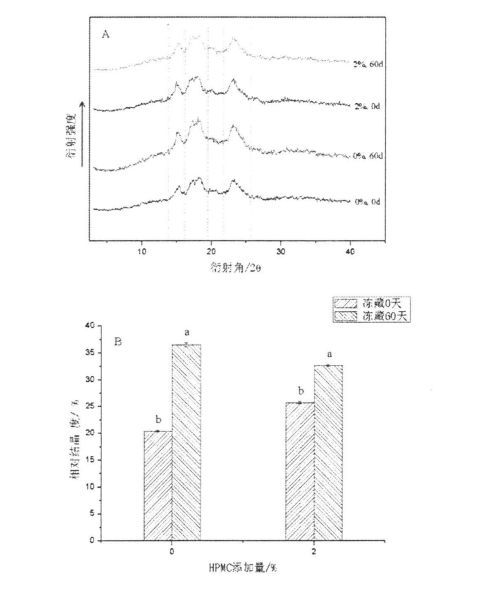
Fig 4.6 Efekto de HPMC -aldono kaj frosta stokado sur XRD -propraĵoj
Note: A is x. X-ray diffraction pattern; B estas la relativa kristala rezulto de amelo;
Starch is the most abundant dry matter in dough, which, after gelatinization, adds unique qualities (specific volume, texture, sensory, flavor, etc.) to the dough product. Since the change of starch structure will affect its gelatinization characteristics, which will also affect the quality of flour products, in this experiment, the gelatinization characteristics, flowability and flowability of starch after frozen storage were investigated by examining starch suspensions with different contents of HPMC added. Changes in rheological properties, thermodynamic properties and crystal structure were used to evaluate the protective effect of HPMC addition on starch granule structure and related properties. The experimental results showed that after 60 days of frozen storage, the starch gelatinization characteristics (peak viscosity, minimum viscosity, final viscosity, decay value and retrogradation value) all increased due to the significant increase in the relative crystallinity of starch and the increase in the content of damaged starch. La gelatiniza entalpio pliiĝis, dum la ĝela forto de amelo -pasto malpliiĝis signife; however, especially the starch suspension added with 2% HPMC, the relative crystallinity increase and starch damage degree after freezing were lower than those in the control group Therefore, the addition of HPMC reduces the degree of changes in gelatinization characteristics, gelatinization enthalpy, and gel strength, which indicates that the addition of HPMC keeps the starch structure and its gelatinization properties relatively stable.
Ĉapitro 5 Efikoj de HPMC -aldono sur feĉo postvivado -indico kaj fermenta agado sub frostigitaj stokadaj kondiĉoj
Yeast has a wide range of applications in fermented flour products (sourdough is obtained by natural fermentation, mainly lactic acid bacteria), it can use the hydrolyzed product of starch in the dough - glucose or maltose as a carbon source, under aerobic conditions, using Substances produce carbon dioxide and water after respiration. The carbon dioxide produced can make the dough loose, porous and bulky. Samtempe, la fermentado de feĉo kaj ĝia rolo kiel manĝebla streĉo ne nur povas plibonigi la nutran valoron de la produkto, sed ankaŭ signife plibonigi la gustajn trajtojn de la produkto. Tial la postviva indico kaj fermenta agado de feĉo havas gravan efikon sur la kvalito de la fina produkto (specifa volumo, teksturo kaj gusto, ktp.) [175].
In the case of frozen storage, yeast will be affected by environmental stress and affect its viability. When the freezing rate is too high, the water in the system will rapidly crystallize and increase the external osmotic pressure of the yeast, thereby causing the cells to lose water; Kiam la glacia indico estas tro alta. Se ĝi estas tro malalta, la glaciaj kristaloj estos tro grandaj kaj la feĉo estos elpremita kaj la ĉela muro difektiĝos; Ambaŭ reduktos la postvivan indicon de la feĉo kaj ĝia fermenta agado. In addition, many studies have found that after the yeast cells are ruptured due to freezing, they will release a reducing substance-reduced glutathione, which in turn reduces the disulfide bond to a sulfhydryl group, which will eventually destroy the network structure of gluten protein, resulting in a decrease in the quality of pasta products [176-177].
5.2.1 Eksperimentaj Materialoj kaj Instrumentoj
BPS. 500cl konstanta temperaturo kaj humideca skatolo
3M Solida Filma Kolonio Rapida Kalkula Testpeco
Ultra-pura senfrukta funkcia tablo
KDC. 160h-altrapida fridigita centrifugilo
Fabrikisto
Angel Yeast Co., Ltd.
Ŝanhaja Spectrum Scientific Instrument Co., Ltd.
Ŝanhaja Zhicheng Analitika Instrumento Fabrikado Co., Ltd.
Weigh 3 g of active dry yeast, add it to a sterilized 50 mL centrifuge tube under aseptic conditions, and then add 27 mL of 9% (w/V) sterile saline to it, shake it up, and prepare 10% (w/w) yeast broth. Poste, rapide translokiĝu al. Stoki en fridujo je 18 ° C. Post 15 d, 30 d, kaj 60 d da frosta stokado, la specimenoj estis elprenitaj por testado. Aldonu 0,5%, 1%, 2%HPMC (p/p) por anstataŭigi la respondan procenton de aktiva seka feĉo -maso. Precipe post kiam la HPMC estas pesita, ĝi devas esti irradiata sub ultraviola lampo dum 30 minutoj por steriligo kaj malinfektado.
5.2.2.3 CFU (Kolon-Formantaj Unuoj) Grafo
Weigh 1 g of dough, add it to a test tube with 9 mL of sterile normal saline according to the requirements of the aseptic operation, shake it fully, record the concentration gradient as 101, and then dilute it into a series of concentration gradients until 10'1. Desegnu 1 ml da diluo el ĉiu el la supraj tuboj, aldonu ĝin al la centro de la 3M -feĉo Rapida Kalkula Testo -peco (kun streĉa selektiveco), kaj metu la ĉi -supran testan pecon en inkubatoron de 25 ° C laŭ la funkciaj postuloj kaj kulturkondiĉoj specifitaj de 3M. 5 D, elprenu post la fino de la kulturo, unue observu la kolonian morfologion por determini ĉu ĝi konformas al la koloniaj trajtoj de feĉo, kaj poste kalkulas kaj mikroskope ekzamenas [179]. Each sample was repeated three times.
The alloxan method was used to determine the glutathione content. La principo estas, ke la reaga produkto de glutationo kaj aloxan havas absorban pinton je 305 nl. Specifa Determina Metodo: Pipeto 5 ml da feĉo -solvo en 10 ml centrifugan tubon, tiam centrifugitan je 3000 rpm dum 10 min, prenu 1 ml da supernatanto en 10 ml centrifugan tubon, miksis 1 ml de 0.2 Mol/ML al la tubo L alloxan, miksita de 0.2 mol de 0.2 mol de 0. Miksi bone, lasu stari dum 6 minutoj, kaj tuj aldonu 1 m, NaOH la solvo estis 1 ml, kaj la absorbanco je 305 nm estis mezurita per UV -spektrofotometro post ĝisfunda miksado. The glutathione content was calculated from the standard curve. Each sample was paralleled three times.
5.2.2.5 Datuma Prilaborado
Experimental results are presented as 4-standard deviation of the mean, and each experiment was repeated at least three times. Analysis of variance was performed using SPSS, and the significance level was 0.05. Uzu originon por desegni grafikaĵojn.

Kiel montrite en Figuro 5.1, kiam frostita dum 0 tagoj, kun la kresko de la kvanto de HPMC aldonita, la pruva alteco de la pasto pliiĝis de 4.234-0.11 cm al 4.274 cm sen aldoni HPMC. -0.12 cm (0.5% HPMC added), 4.314-0.19 cm (1% HPMC added), and 4.594-0.17 cm (2% HPMC added) This may be mainly due to HPMC Addition changes the properties of the dough network structure (see Chapter 2). However, after being frozen for 60 days, the proofing height of the dough decreased to varying degrees. Specifically, the proofing height of the dough without HPMC was reduced from 4.234-0.11 cm (freezing for 0 days) to 3 .18+0.15 cm (frozen storage for 60 days); the dough added with 0.5% HPMC was reduced from 4.27+0.12 cm (frozen storage for 0 days) to 3.424-0.22 cm (frozen storage for 0 days). 60 tagoj); La pasto aldonita kun 1% HPMC malpliiĝis de 4.314-0.19 cm (frosta stokado dum 0 tagoj) ĝis 3.774-0.12 cm (frosta stokado dum 60 tagoj); while the dough added with 2% HPMC woke up. La hara alteco reduktiĝis de 4.594-0.17 cm (frosta stokado dum 0 tagoj) al 4.09- ± 0.16 cm (frosta stokado dum 60 tagoj). Videblas, ke kun la kresko de la aldona kvanto de HPMC, la grado de malpliigo de la pruva alteco de la pasto iom post iom malpliiĝas. Ĉi tio montras, ke sub la kondiĉo de frosta stokado, HPMC ne nur povas konservi la relativan stabilecon de la pasto -reto -strukturo, sed ankaŭ pli bone protekti la postvivan indicon de feĉo kaj ĝian fermentan produktadon de gaso, tiel reduktante la kvalitan difekton de fermentitaj nudeloj.
In the case of frozen storage, since the frozen water in the dough system is converted into ice crystals, the osmotic pressure outside the yeast cells is increased, so that the protoplasts and cell structures of the yeast are under a certain degree of stress. When the temperature is lowered or kept at low temperature for a long time, a small amount of ice crystals will appear in the yeast cells, which will lead to the destruction of the cell structure of the yeast, the extravasation of the cell fluid, such as the release of the reducing substance - glutathione, or even complete death; Samtempe, la feĉo sub media streso, ĝia propra metabola agado reduktiĝos, kaj iuj sporoj estos produktitaj, kio reduktos la fermentan gasan produktadon de feĉo.
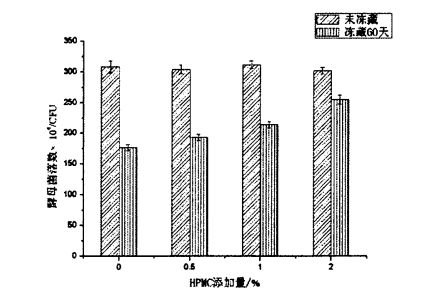
It can be seen from Figure 5.2 that there is no significant difference in the number of yeast colonies in samples with different contents of HPMC added without freezing treatment. This is similar to the result determined by Heitmann, Zannini, & Arendt (2015) [180]. Tamen post 60 tagoj da frostado, la nombro de feĉaj kolonioj malpliiĝis signife, de 3.08x106 CFU al 1.76x106 CFU (sen aldoni HPMC); from 3.04x106 CFU to 193x106 CFU (adding 0.5% HPMC); reduktita de 3.12x106 CFU al 2.14x106 CFU (aldonita 1% HPMC); reduced from 3.02x106 CFU to 2.55x106 CFU (added 2% HPMC). Kompare, oni povas trovi, ke la streĉado de la frostiga stokado kaŭzis la malpliiĝon de la feĉo -kolonia nombro, sed kun la kresko de HPMC -aldono, la grado de la malpliigo de la kolonia nombro malpliiĝis laŭvice. This indicates that HPMC can better protect yeast under freezing conditions. The mechanism of protection may be the same as that of glycerol, a commonly used strain antifreeze, mainly by inhibiting the formation and growth of ice crystals and reducing the stress of low temperature environment to yeast. Figure 5.3 is the photomicrograph taken from the 3M yeast rapid counting test piece after preparation and microscopic examination, which is in line with the external morphology of yeast.
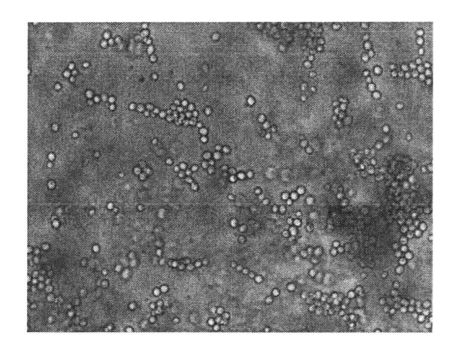
5.3.3 Efikoj de HPMC -aldono kaj frostiga tempo sur glutationa enhavo en pasto
Glutationo estas tripeptida komponaĵo kunmetita de glutamika acido, cisteino kaj glicino, kaj havas du specojn: reduktita kaj oksidita. When the yeast cell structure is destroyed and died, the permeability of the cells increases, and the intracellular glutathione is released to the outside of the cell, and it is reductive. Ĝi aparte valoras rimarki, ke reduktita glutationo reduktos la disulfidajn ligojn (-ss-) formitajn de la interligo de glutenaj proteinoj, rompante ilin por formi liberajn sulfhidrilajn grupojn (.SH), kiuj siavice efikas sur la pasto-reto-strukturo. stability and integrity, and ultimately lead to the deterioration of the quality of fermented flour products. Kutime, sub media streĉo (kiel malalta temperaturo, alta temperaturo, alta osmotika premo, ktp.), Feĉo reduktos sian propran metabolan agadon kaj pliigos sian streĉan reziston, aŭ produktos sporojn samtempe. Kiam la mediaj kondiĉoj taŭgas por ĝia kresko kaj reprodukto denove, tiam restarigu la metabolon kaj proliferadon. However, some yeasts with poor stress resistance or strong metabolic activity will still die if they are kept in a frozen storage environment for a long time.
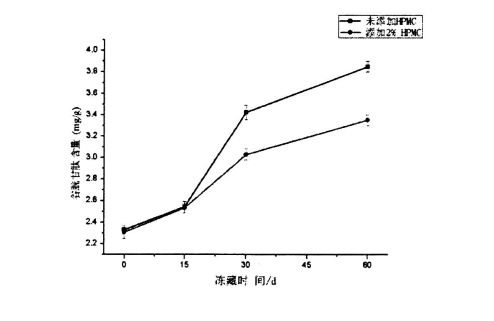
Fig 5.4 Efekto de HPMC -aldono kaj frosta stokado sur la enhavo de glutationo (GSH)
Afiŝotempo: Okt-08-2022







